 | |
| Type | Public |
|---|---|
| Industry | Manufacturing |
| Founded | April 1, 1876le |
| Founder | Benno Orenstein Arthur Koppel |
| Defunct | January 1, 1999 |
| Fate | Acquired |
Area served | Worldwide |
| Products | Railway vehicles Heavy equipment Escalators |
| Parent | New Holland Construction |
Orenstein & Koppel (normally abbreviated to "O&K") was a major German engineering company specialising in railway vehicles, escalators, and heavy equipment. It was founded on April 1, 1876, in Berlin by Benno Orenstein and Arthur Koppel.
Originally a general engineering company, O&K soon started to specialise in the manufacture of railway vehicles. The company also manufactured heavy equipment and escalators. O&K pulled out of the railway business in 1981. Its escalator-manufacturing division was spun off to the company's majority shareholder at the time, Friedrich Krupp AG Hoesch-Krupp, in 1996, leaving the company to focus primarily on construction machines.[1] The construction-equipment business was sold to New Holland Construction, at the time part of the Fiat Group, in 1999.[2][3]
Founding and railway work

The Orenstein & Koppel Company was a mechanical-engineering firm that first entered the railway-construction field, building locomotives and other railroad cars.
First founded in 1892 in Schlachtensee, in the Zehlendorf district of Berlin, and known as the Märkische Lokomotivfabrik, the O&K factories expanded to supply the Imperial German Army under Kaiser Wilhelm II with field-service locomotives, or Feldbahn. O&K supplied all manner of railway equipment to the Army. Because of strained capacity at the Schlachtensee shops, work transferred in 1899 to a site in Nowawes, later Babelsberg, near Potsdam. Around 1908, O&K acquired the firm of Gerlach and König in Nordhausen, building petrol and diesel locomotives there under the trade mark "Montania".
Diversification

.jpg.webp)
O&K expanded to build freight and passenger cars, and above all, excavators for construction. The company also built other heavy equipment, including graders, dump trucks, forklift trucks, compressors, crawler loaders, wheeled loaders, road rollers, and truck cranes.
The company also began manufacturing escalators, transmissions, rapid-transit railway lines, buses, tractors, and cargo ships. Passenger liners, shipboard cranes, and shipbuilding enterprises rounded out the company's profile. Because of the company's thriving export business, a worldwide system of branch offices was created.
In the early years of the 20th century, O&K built bucket chain trenchers, at first from wood, and—after 1904—completely from steel. These were propelled by steam or oil engines. O&K also made railway trenchers for work in heavy soils.
In the First World War, O&K built railway engines and cars of all sizes for the German government. With the collapse of Imperial Germany in November 1918, the victorious Allies put further restrictions on German manufacturing and military capacity, seizing all army Feldbahn engines as per the terms of the Versailles Treaty that ended the First World War. The treaty also removed access to export markets; at the end of 1925, work stopped for three months as a result of the lost business. By 1935, business had recovered and the company produced 5,299 locomotives. After the war, O&K's American subsidiary, the Orenstein-Arthur Koppel Company, was seized by the Alien Property Custodian and sold at an auction where only United States citizens were allowed to place bids.[4]
Besides the Feldbahn contracts, the company produced Series 50 steam locomotives and standard gauge vehicles in the 1930s. They also delivered some broad gauge CSÉT shunting locomotives with a gauge of 5 ft 3 in (1,600 mm) to the Irish Sugar Company (Comlucht Siúcre Éireann) in Ireland (2 of which have been preserved). The company produced diesel locomotives, and Series 44 and Series 50 steam engines, for the national railway company, Deutsche Reichsbahn-Gesellschaft.
In 1922, they manufactured their first continuous-track steam shovel. In 1926, diesel engines replaced steam engines; the company converted earlier steam units to diesel power as the need arose. O&K merged with a kerosene-engine builder, selling the engines under the O&K banner.
Nazi era and the Second World War

At the Spandau factory, O&K built cable-operated excavators and bucket-wheel excavators for use in the lignite coal mines of eastern Germany. Under the Aryanisation scheme of Adolf Hitler's Nazi Germany, the Orenstein family's shares in the company were forcibly sold in 1935; Orenstein and Koppel was placed under trust administration, and the Babelsberger works were taken over and renamed in 1941. O&K existed in name only, but more commonly used the abbreviation MBA (Maschienenbau und Bahnbedarf AG).
After heavy bomb attacks on Berlin caused a fire in the company's plant-administration buildings, factory production minister Albert Speer redistributed work and factories around the country to lessen the risk from a single attack. For the remainder of World War II, no more locomotives were built in Berlin. Four hundred and twenty-one locomotives already under construction were shifted to Prague to protect the existing factories. During the war, O&K provided 400 Class 52 locomotives.
East Germany
After the end of the war, the locomotive plant in Nordhausen went idle. Under the German Democratic Republic, O&K changed its name to the VEB Company, and resumed heavy mechanical manufacturing at Nordhausen, producing cable-operated excavator shovels, among other things.
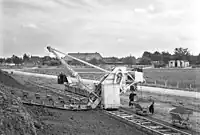
By 1946, the Babelsberg factory resumed production of locomotive boilers, and one year later the plant delivered its first postwar locomotive.
The German Democratic Republic nationalised the railroads and rolling stock manufacturers. The O&K plants in Babelsberg were renamed the LOWA Lokomotiv Plant Karl Marx (LKM). The LKM became the sole manufacturer of diesel locomotives for the GDR, such as the large DRG V180. In the late 1950s, the plant developed steam and diesel engines for the Deutsche Reichsbahn narrow-gauge railways, building approximately 4,160 engines.
Construction of steam locomotives ended in 1969, leaving diesel-hydraulic locomotives as the company's priority. The company's last diesel locomotive was the DB Class V 60D, manufactured until 1976. Over the course of 30 years as LKM, the company produced approximately 7,760 locomotives; about a third of that number were manufactured for export.
By 1964, the company had expanded into air-conditioning and refrigeration technology.
West Germany
In West Germany, the enterprise resumed operation after World War II in 1949, under the name Orenstein & Koppel AG, with headquarters in Berlin. In 1950, it incorporated under that name after merging with the Lübecker Crane Company. After the construction of the Berlin Wall in 1961, the head office moved to Dortmund.
By the mid-1970s, the enterprise had grown steadily. In 1972, O&K had five working plants: West Berlin, Dortmund, Hagen, Hattingen/Ruhr, and Lübeck; it maintained a central spare-parts service in Bochum. That year, the company had 8,530 employees. The company had 24 business and sales offices in West Germany, and agencies on all five populated continents.
The West German company emphasised the manufacture of railroad cars and construction equipment, particularly excavators. In 1961, O&K manufactured Europe's first series of fully hydraulic excavators. They manufactured over 55,000 hydraulic excavators; more than 700 of those were rated at over 100 tons' service weight. O&K also manufactured the world's largest hydraulic excavator, at 900 tons' service weight with a shovel capacity of over 52 cubic metres (68 cu yd) and an engine output of 2,984 kilowatts (4,055 HP).
The company also diversified into escalator manufacturing.
Decline
After 1964, the railway-manufacturing unit was separated from the other production units.
The railway business was transferred to Bombardier, which continues to manufacture rolling stock in Berlin. The Babelsberg site became an industrial park.
The escalator-manufacturing division was sold to the company's majority shareholder at the time, Friedrich Krupp AG Hoesch-Krupp, in 1996.[1]
The construction-equipment business was sold to New Holland Construction, at the time part of the Fiat Group, in 1999.[2][3]
Steam locomotives
Tank locomotives with two coupled axles (Type 0-4-0)
Based on O&K's experience, they have created a number of type 0-4-0 standard designs, which have proven to be particularly suitable for many companies. Locomotives of these standard designs were always under construction, and locomotives of the most common strengths were always in stock, so that they could be dispatched immediately on request. Two-axle locomotives were mainly used by construction companies and industrial establishments; accordingly, special emphasis was placed on simple and practical construction. In particular, the locomotives were characterised by high tractive power, while the smaller types were generally based on a lower speed in favour of tractive power.[5]
The standard-gauge locomotives in this category were particularly suitable for shunting and for operating purposes on branch lines.[5]
For light railways, especially for narrow-gauge railways, with steep gradients, tight curves and generally a light superstructure and substructure, locomotives with only two axles did often not meet the requirements in terms of tractive force and caused wear of the track and the wheel tyres due to their wheel load. Therefore, larger locomotives with more axles were available, as shown below.
Tank locomotives with three coupled axles (Type 0-6-0)
As with the two-axle coupled locomotives, the full weight of the machines with three coupled axles was used as adhesion weight. However, since the wheel pressure was distributed over six wheels instead of four, locomotives of this category could run on much lighter rails than two-axle locomotives with the same weight and therefore the same tractive force. This type of locomotive could therefore be used wherever the existing track required the most powerful locomotive possible without exceeding the permissible wheel pressure, or where the superstructure was to be constructed relatively lightly. Particularly on longer lines, the latter was considered for the sake of substantial savings. However, the track curves must be larger when using this locomotive than with the four-wheelers.[6]
Locomotives with two coupled axles and one svivelling axle (Types 2-4-0 or 0-4-2)
If the locomotive had to travel through small curves with a light superstructure, it was advisable to purchase a locomotive with two axles and a svivelling axle. This type was especially suitable for longer distances because, it allowed a light superstructure and was also able, to carry larger supplies than 0-4-0 locomotives with the same wheel pressure. The design also had the advantage that the centre of gravity could be set lower than on other types. This, together with the large wheelbase, gave the machines a particularly smooth ride. It could also run at a relatively higher speed, so that, according to the above, it was mainly suitable for small railways and feeder lines. Depending on the particular conditions, O&K installed the svivelling axle at the rear or at the front, but always in such a way that the greatest possible adhesive weight was maintained. Since the full weight of this type of machine could never be used as the adhesive weight, this construction was less suitable for carrying large loads. For such cases OK recommended the use of multi-axle coupled locomotives of the Gölsdorf type or, if small curves were available, to the locomotives of the Mallet or Klien-Lindner type, as shown below.[7]
Coupled compound locomotives (Type 0-4-4-0, Mallet design)
In many cases, where 0-4-0 or 0-6-0 steam locomotives were no longer sufficient, O&K built 0-4-4-0 or 0-6-6-0 compound locomotives, Mallet design, which supplemented the more conventional looking 0-4-2 locomotives (in Germany categorized as 2×2/2 and 2x3/3 double compound locomotives in comparison to the more conventional looking 2/3 locomotives). Apart from the possibility of being used on light superstructures and small curves, the locomotive had the advantage of great tractive power due to the composite arrangement of the cylinders, as the full weight was used as adhesion weight. The design was such that the boiler, driver's cab and storage boxes were connected to the rear frame, which carried the high-pressure cylinders, while the front frame, on which the low-pressure cylinders were located, was connected to the rear frame by two vertical hinges. The boiler with the water boxes rested on a slide track of the front frame, so that the latter could move freely under the boiler. The steam passed from the regulator in fixed pipes to the high-pressure cylinders and, after expansion in these, through an absolutely steam-tight, flexible, well-insulated pipe to the low-pressure cylinders. The exhaust steam entered the exhauster through a vertical movable pipe. A special valve made it possible to feed boiler steam directly to the low-pressure cylinders, so that all four cylinders came into operation immediately when the locomotive was started-up.[8]
Locomotives with coupled hollow axles with radial and lateral movement (Klien-Lindner design)
For railways with steep gradients and relatively light track construction, locomotives with two or three coupled axles often did not meet the requirements of increased traffic. Due to the high costs involved, the existing tracks could often not be converted, and heavier locomotives with a larger number of axles were used. Where small curvatures precluded the use of long, fixed wheelbases, locomotives with steerable bogies or, for the sake of simplicity, locomotives with curvilinear coupled axles were often used. The acquisition of such locomotives was also advisable for such new designs where the track systems and bridges were easier and cheaper to build. Since 1901, locomotives with coupled hollow axles have been built in particular according to the Klien-Lindner design, which has proved extremely successful in operation. The advantages of this design were:
- Large tractive force at a given permissible wheel pressure
- Large wheelbase with the best curve mobility and equal spring loading on both sides of each end axle and thus safe running of the locomotive
- Shock-free running into curves, as well as safe return to the centre position when running on straight track
- Equally good running when driving forwards and backwards
- Low wear of the rails and wheel tyres
._O%2526K_Lokomotiven_mit_lenkbaren_Kuppelachsen_(Hohlachsen)_mit_Radial-_und_Seitenbewegung_(Bauart_Klien-Lindner).jpg.webp)
The arrangement and mode of operation was as follows: The laterally and radially movable coupled axle was installed as the end axle, and in the case of eight- or ten-wheelers, these steering axles arranged at both ends ensured that the locomotive could enter the curves without difficulty. All axles were coupled in the usual way by fixed rods and mounted in axle bushes "bb" outside the wheels, following the spring play. The axle bushes sit in a continuous, fixed frame on which the steam cylinders are arranged in the usual way. The steering axle consists of a core axle "a" fixed in "bb" and driven in the usual way, and a hollow axle "c" which is firmly connected to the wheels and can be moved laterally and radially and which encloses the core axle, which is provided with a ball attachment in the middle, by means of a two-part ball cup "d".[9]
The load on the axle was distributed by the ball pivot of the core axle "a" as it were by a transverse balancer on both wheels of the axle and thus equal wheel pressures and safety against derailment are obtained. The hollow axle is driven by a driving pin "f" pressed into the ball pivot of the core axle with sliding pieces at both ends, which have the necessary lateral play in the housing of the hollow axle for the deflection of the axle. In order to return the hollow axle to its central position after deflection, either return springs are arranged in the central housing, or, as can be seen in the following illustration, counter-guides "g" are arranged which, by means of brackets, enclose the hollow axles in the auxiliary bearing positions "ee" and effect unconstrained, shock-free adjustment of the hollow axle, since both end axles must execute their radial or lateral movement simultaneously. In order to counteract the unsteady running of the steering axles on the track and any lurching of the locomotive, these locomotives are fitted with an adjustable safety device which holds the drawbar frames in the central position on the track by means of spring tension; no pressure is exerted against the bearing points with this resetting device. These axles do not require any maintenance except for periodic lubrication. The periodic lubrication mentioned is only necessary at intervals of 1 to 2 months and is carried out after loosening the two lubricating screws "s" located on the centre of the axle by introducing grease or viscous oil into the sliding boxes of the driving pin. Only during a general inspection of the locomotives is it necessary to also inspect the hollow axles to make sure that the internal parts are in good condition.[10]
O&K have used the Klien-Lindner axles for the Royal Prussian State Railways and many other railway in large numbers. The administration of the military railway has also introduced 0-8-0 locomotives with steerable coupled axles in place of the 0-6-0 field railway locomotives previously built.
Locomotives with laterally movable coupled axles (Gölsdorf design)
Locomotives of the Gölsdorf design were only suitable for lines, on which there were relatively few and large curvatures. In this case it was sufficient to shift one or more coupling axles sideways in such a way that the movable axles were not guided in their axle bearings but by their own flanges. The bearings of the coupling rods have the same lateral play on their journals as the axles in the axle bearings. This type of construction has proven itself well on eight- and multi-wheel locomotives, but it was not suitable for very small curvatures. In terms of performance and even load distribution, etc., it was equivalent to the more common Klien-Lindner locomotives. They were used for main, branch and small railways.[11]
Two of the five axles of a ten-wheel locomotive could move sideways relative to the frame because their axle boxes fixed them rigidly to the frame. The other axles, however, were fitted into their bearings and attached to their drives in such a way that they can be moved sideways during curve running, depending on the sideways forces acting on them. In addition the connecting and coupling rods, through which linear forces from the steam pistons were translated into the rotation of the wheels via the crank pins, also had to be able to move sideways.
Tramway locomotives (Type 0-4-0)
O&K built tramway locomotives, which were used for operation on tramways serving public traffic, either with a driver's cab at the front and rear or with only one driver's cab in the middle of the locomotive; furthermore with a power unit cover in two different designs. Whereas one version only served to conceal the engine from road traffic, the other version served to protect the engine parts against dust. The desired type of covering is to be specified. The weight of this locomotive was relatively high and therefore it could develop a great performance immediately when starting up, even on short gradients. This was effectively supported by a high steam overpressure, which O&K usually provided for these locomotives with 14 bars (200 psi).[12]
The fairing of all moving parts was intended to protect other road users such as pedestrians from serious injuries in case of accidents. It also prevented horses from shying and protected the transmission from dirt and dust on the unpaved roads that were common at the time. Often there was no stoker on tram locomotives, which meant they were operated by the driver in one-man operation. The short axle stands also ensured that narrow curves could be negotiated in city centres. Often, standing boilers were used for reasons of space.
Mining and tunnel locomotives
For operation in tunnels or mine, O&K built locomotives in compliance with specific profiles. In the case of steam locomotives, it was possible to run them at high speed by fitting suitable devices and using particularly large boilers that could store a larger quantity of steam before passing through the tunnel. For use during tunnel construction or in underground mines, steam locomotives with oil firing equipment were particularly suitable, whereby smoke development and spark emission did not take place. The handling of these locomotives did not differ in any other respect from that of an ordinary locomotive. Furthermore, fireless locomotives were also very suitable for operation in tunnels and mines, as they completely avoid the nuisance of smoke, gases and sparks. Compressed air locomotives, which, however, required a special stationary system to generate the compressed air were also made and sold in smaller numbers.[13]
Fireless locomotives
Fireless locomotives were particularly suitable for use inside factories, yards etc., where it was essential to secure absolute freedom from any risk of fire. They were largely used for shunting purposes for paper mills, oil mills, wool mills, timber yards, gunpowder factories and similar works. These locomotives were constructed without fire boxes, the necessary steam being taken from a stationary boiler. The locomotive is able to work for several hours with one filling and can be operated with minimum expense as the driver needed less skills than that of a conventional steam engine.[14]
Rack locomotives
O&K delivered several types of cogwheel locomotives for mixed railways, on which ordinary operation alternated with cogwheel operation. Mixed railways were used in changing terrains with only single steep gradient, which could not be negotiated by ordinary adhesion locomotives. Accordingly, only these steep gradients were equipped with toothed bars. The mode of operation was as follows: The two steam cylinders outside the frame drove the driving gearwheel for the rack by means of a double gearing with the appropriate transmission. This driving gear wheel sat on a special axle fixed in the frame and was connected to the friction axles by coupling rods, so that the gear wheel axle and friction axles were driven simultaneously. The locomotives could therefore run on normal rail tracks as well as on toothed tracks. On the toothed track, the driving gear and the friction wheels worked together. The effect of the latter was also utilised on the toothed track and the load on the rack was relieved accordingly. The locomotives worked either on a simple flat steel rack or on Riggenbach ladder rack.[16] A cumulative number of only 6 to 9 rack steam locomotives were made by O&K in total. Their track gauge ranged from 400 mm (15+3⁄4 in) to 1,300 mm (4 ft 3+3⁄16 in).[17]
Locomotives with a separate tender
Locomotives with a separate tender did not carry all their fuel and water on board the locomotive and were thus particularly useful for travelling long distances without being refuelled. The locomotives were equipped to be either heated by coal, wood or oil, because a larger heating and grate area were required. The main types had from four to twelve wheels for the locomotive and four, six or eight wheels on the tender.
The water tanks were firmly fastened to the frame of the tender, while maintaining a low centre of gravity. The coupling between locomotive and tender was similar to that of the waggons, to ensure that the locomotive could be driven without the tender for shunting or on short distances. The tender was easily accessible from the engineer's cab. If the locomotive was heated by wood, the tender had a special fence to increase the volume of its load.
Coupled compound locomotives (Type 0-6-6-0, Kitson-Meyer design)

After Orenstein & Koppel (O&K) had delivered the prototype of a Kitson-Meyer locomotive for the 600 mm gauge to the Chilean military railway in 1927, an order for three locomotives followed in 1937. In 1939, the locomotives with the factory numbers 13306 to 13308 were completed. The locomotives had riveted bridge and bogie frames. The boiler, cab, reservoir and ash box were also riveted. The engines located at the two bogie ends worked on the centre axle set. This wheelset could also be sanded. The control system was of the Heusinger type. While the prototype had a Westinghouse brake, the production locomotives had a Knorr brake. The air pump was attached to the rear water tank, while the main air tank was above it on the water tank. The locomotive had electrically operated headlights.
Due to the beginning of the Second World War, the vehicles could not be delivered to Chile. They were then tested by O&K on the Rehagen-Klausdorf army training area and probably also on lines of the Mecklenburg-Pomeranian narrow-gauge railway. In 1944, the Deutsche Reichsbahn acquired the locomotives to use them on lines in occupied Poland. Therefore, in the second half of the same year, they were handed over to Gedob Direktion Krakow, where they were stationed at BW Jedrzejow.[18]
List of Orenstein & Koppel steam locomotives
The list of Orenstein & Koppel steam locomotives shows photographically documented samples of representative Orenstein & Koppel (O&K) steam locomotives. The factory produced 14,387 steam locomotives from 1899 to 1945 at its Berlin site (Drewitz, Nowawes, Babelsberg) with the works number range from 337 to 12965.
| Works No | Year | Photo | Wheel arrangement | Gauge | Power | Use |
|---|---|---|---|---|---|---|
| 226-228 | 1897 | _O%2526K_works_N%C2%B0_226-228_of_1897.jpg.webp) | 2-4-0 | 1,435 mm (4 ft 8+1⁄2 in) | 150 hp | Lemvigbanen, Denmark |
| 302 | 1898 | _eingesetzt_wurde._Danach_mehrwe_Besitzer%252C_inkl._Firma_Veba_AG_in_Z%C3%BCrich_am_Flughafen%252C_Patrick_Keller_und_Daniel_Rutschmann.webp.png.webp) | 0-4-0 | 750 mm (2 ft 5+1⁄2 in) | 50 hp | Sugar facztory Tapiau, construction of Zurich Airport, VEBA, Latvia Tp782, preserved at Private owner, Rorschach, Switzerland Täuffelen[19] |
| 366 | 1899 | 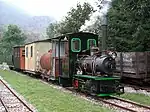 | 0-4-0 | 600 mm (1 ft 11+5⁄8 in) | 20 hp | Delivered via the O&K sales office in Budapest to Earl Károly Imre in Nagymágócs near Oroszhaza. 1941 used at the fortifications in Szolyva and in 1945 returned to Mattersburg in Austria. Now being operated in Feld- und Industriebahnmuseum Freiland, Austria.[20] |
| 367 | 1899 | .jpg.webp) | 0-4-0 | 600 mm (1 ft 11+5⁄8 in) | Delivered via the Swedish general agent Carl Ström to the Hamra–Tumba Järnvägen of Gustaf de Laval on Gotland in Sweden. From 1916 owned by the construction company Byggnads AB, who sold it to the city of Stockholm in 1917 for work on Hammarbyleden.[21] | |
| 1899 |  | 0-6-0 FL | Fireless locomotive | |||
| 418 | 1899 |  | 0-6-0 | 785 mm (2 ft 6+29⁄32 in) | Bröl Valley Railway, BTE 14–17 | |
| 531 | 1900 |  | 0-4-2 | 600 mm (1 ft 11+5⁄8 in) | 60 hp | Initially at sugar mill Nakel (Cukrownia Nakło), now Narrow Gauge Railway Museum in Wenecja, Poland[22] |
| 533 | 1899 |  | 0-6-2 | 600 mm (1 ft 11+5⁄8 in) | 60 hp | Kleinbahngesellschaft Krone, für Wirsitzer Kleinbahn '9' |
| 576-578 | 1900 |  | 0-4-4-0 Mallet | 750 mm (2 ft 5+1⁄2 in) | 120 hp | Kalan |
| 591 | 1900 | %252C_Germany%252C_in_1901.jpg.webp) | 0-4-2 | 600 mm (1 ft 11+5⁄8 in) | 80 hp | Kirchlengern–Hille railway (Wallückebahn) in Germany |
| 592 | 1900 | _02.png.webp) | 0-4-0, later 0-4-2 | 600 mm (1 ft 11+5⁄8 in) | 80 hp | Kirchlengern–Hille railway (Wallückebahn) in Germany |
| 596 | 1900 |  | Initially 0–4–0, later 0-6-0 | 1,000 mm (3 ft 3+3⁄8 in) | 125 hp | Soest No 9 of the Ruhr-Lippe-Eisenbahn##6shy;gesellschaft in Germany |
| 614 | 1900 |  | 0-4-0 | 750 mm (2 ft 5+1⁄2 in) | 30 hp | Initially Pakis Baru 1, now Statfold Barn Railway |
| 617 | 1900 |  | 0-6-2 | 750 mm (2 ft 5+1⁄2 in) | 100 hp | Two-cylinder locomotive with three coupled axles and one radial axle. Steam bell, outer frame, upper water tanks. Delivered to the Rosenberger Kreisbahn |
| 683 | 1900 |  | 0-4-0 | 508 mm (1 ft 8 in) | 10 hp | Dinty, Cosmopolitan Proprietary Mine, Kookynie, Western Australia[23][24] |
| ca 1900 |  | 0-4-0 | 610 mm (2 ft) | Moira Coal Mine, Collie, Western Australia | ||
| ca 1900 |  | 0-4-0 | Sugar cane plantation of the Nederlandsch-Indische Spoorwegen | |||
| ca 1900 | .jpg.webp) | Douglas, Port Douglas Tramway from Mossman to Port Douglas in Queensland, Australia | ||||
| 687 | 1901 | .jpg.webp) | 0-4-0 | 600 mm (1 ft 11+5⁄8 in) | 20 hp | Ceper 2, PG Gondang Baru, Klaten, Indonesia |
| 718 | 1901 | .jpg.webp) | 0-4-0 | 610 mm (2 ft) | 30 hp | Magnet № 2, Magnet Silver Mining Co, Tasmania,[23] now Wee Georgie Wood Railway |
| 719 | 1901 | .jpg.webp) | 0-4-0 | 610 mm (2 ft) | 30 hp | Ordered by North Mount Farrell Mining in Tasmania but not operated there, later Cairns Town Council, Edge Hill Tramway, Queensland[23] |
| 723 | 1900 | .jpg.webp) | 0-4-0 | 610 mm (2 ft) | 30 hp | Kearsney–Stanger Light Railway in the Colony of Natal (now KwaZulu-Natal in South Africa)[25] |
| 724 | 1900 |  | 0-6-0 | 610 mm (2 ft) | 50 hp | Kearsney–Stanger Light Railway in the Colony of Natal (now KwaZulu-Natal in South Africa[26] |
| 725 |  | 4-2-0 | 600 mm (1 ft 11+5⁄8 in) | 40 hp | Monte Alegre for the Usina Monte Alegre sugar mill in Piracicaba in São Paulo Brazil | |
| 731 | 1902 |  | 0-4-2 | 610 mm (2 ft) | 40 hp | East Murchison United Ltd, Lawlers, Western Australia[23] |
| 772 | 1901 | .jpg.webp) | 0-4-2 | 600 mm (1 ft 11+5⁄8 in) | 60 hp | Jatiroto J70, Jatiroto, PG Jatiroto, Indonesia |
| 773 | 1901 | .jpg.webp) | 0-4-2 | 600 mm (1 ft 11+5⁄8 in) | 60 hp | Ngadirejo 71, PG Ngadirejo, Kediri, Indonesia |
| 777 | 1901 | .jpg.webp) | 0-4-2 | 600 mm (1 ft 11+5⁄8 in) | 60 hp | Pajarakan 2 Kelut, PG Pajarakan, Probolinggo, Indonesia |
| ca 1901 |  | 0-4-2 | 700 mm (2 ft 3+9⁄16 in) | 60 hp | Tender locomotive with open cab, traction pump, suspension, hand bell, melting plug. Built according to Dutch-Indian regulations. Delivered to India. | |
| 810 | 1902 |  | 0-4-0 | The so-called Stink Express disposed waste and sewage sludge in Jodhpur, Rajasthan, India | ||
| 819 | 1901 | .jpg.webp) | 0-4-0 | 825 mm (2 ft 8+1⁄2 in) | 20 hp | Burdekin, James Boyd, firewood supplier, Charters Towers, Queensland, Australia[23] |
| 851 | 1902 | .jpg.webp) | 0-4-0 | 600 mm (1 ft 11+5⁄8 in) | 30 hp | Initially P. Dinndorf, Strasbourg, now agricultural museum in Eschach-Seifertshofen, Germany |
| 882 | Delivered 1901 | .jpg.webp) | 0-4-4-0 Mallet | 610 mm (2 ft) | Magnet Tramway No. 2, Tasmania. Supplied by Central Mining & Tramway Appliances Proprietary Ltd 1901.[27][23] | |
| 893 | 1901 | .jpg.webp) | 0-4-2 | 600 mm (1 ft 11+5⁄8 in) | 60 hp | Merican 4, PG Merican, Kediri, Indonesia |
| 894 | 1901 | .jpg.webp) | 0-4-2 | 600 mm (1 ft 11+5⁄8 in) | 60 hp | Merican 6, PG Merican, Kediri, Indonesia |
| 898 | 1901 | .jpg.webp) | 0-4-2 | 600 mm (1 ft 11+5⁄8 in) | 60 hp | Rejosari 1 PG Rejosari, Madiun, Indonesia |
| 930 | 1902 | 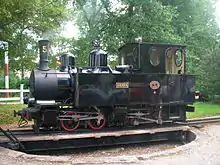 | 0-4-4-0 Mallet | 600 mm (1 ft 11+5⁄8 in) | 80 hp | No 5 Hamra, Östra Södermanlands Järnväg, Sweden |
| ca 1902 |  | 0-4-4-0 Mallet | 600 mm (1 ft 11+5⁄8 in) | Toul № 1, Public works company Estrade-Taher, France | ||
| ca 1902 |  | 0-4-0 | 1,000 mm (3 ft 3+3⁄8 in) | 125 hp | Two-cylinder compound locomotive with two coupled axles. Supplied to the Ruhr-Lippe-Kleinbahnen. Steam bell, vacuum brake (König system), central lubrication device | |
| ca 1902 |  | 0-4-0 | ||||
| ca 1902–1912 | 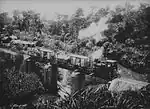 | 0-4-4-0 Mallet | 750 mm (2 ft 5+1⁄2 in) | Sigi railway, Tanzania | ||
| 979-981 | ca 1903 | %252C_Betriebs-Nr._1-3.jpg.webp) | 0-6-0 | 1,435 mm (4 ft 8+1⁄2 in) | Merzig-Büschfeld railway company, Merzig/Saar, service No. 1-3 | |
| 1001 | 1905 | .jpg.webp) | 0-6-0 | 107 hp | Asturias, № 6, narrow gauge railway Valdepeñas–Puertollano (El trenillo de La Calzá), Spain[28] | |
| 1080 | 1903 |  | 0-6-0 | 1,000 mm (3 ft 3+3⁄8 in) | Sold to Jallut via the Orenstein & Koppel office in Brussels[29] | |
| 1089 |  | 0-4-4-0 Mallet | 1,000 mm (3 ft 3+3⁄8 in) | Lenz Type ii, built by Orenstein & Koppel, No 11–16 | ||
| 1134 | 1903 | _02.jpg.webp) | 0-4-0 | 762 mm (2 ft 6 in) | 40 hp | Port Kunda Cement Factory |
| 1166 | 1903 |  | 0-4-0 | 600 mm (1 ft 11+5⁄8 in) | 50 hp | Minas de Utrillas[30] |
| 1162 | 1903 |  | 0-4-0 | 750 mm (2 ft 5+1⁄2 in) | 80 hp | Initially Jacob & Bartisch construction company, Leipzig, later lignite mine Concordia, Nachterstedt, from 1930 lignite mine Gewerkschaft Humboldt, Thüste-Wallensen 8, since 1966 exhibited at the playground Seelze-Letter, since 1994 Emmerthal-Lüntorf, since 1996 narrow gauge museum Rittersgrün, Saxony, Germany |
| 1167 | 1903 | .jpg.webp) | Bn2t | 600 mm (1 ft 11+5⁄8 in) | 50 hp | Turba 3, Minas de Utrillas, Spain, since 1983 at the heritage railway Paderborn, since 1985 Guldental 1, Heddesheimer Feldbahn H&G Faust |
| 1211 | 1903 |  | 0-6-0 | 1,435 mm (4 ft 8+1⁄2 in) | 250 or 300 hp | KED Berlin, T3 Han 1858, Han 6197, DRB 89 7458 with Allan straight link valve gear |
| 1339 | 1904 |  | 0-4-0 | 600 mm (1 ft 11+5⁄8 in) | 10 hp | Initially Rigeo–Eretria railway, now railway museum Athens |
| 1358 | 1904 | .jpg.webp) | 0-4-4-0 Mallet | 600 mm (1 ft 11+5⁄8 in) | Mallet locomotive with outer cylinders for the Bromberger Kreisbahnen ("von Eisenhardt") | |
| 1403, 1404 | 1905 | _and_-2128_from_1906_(via_Hermann_Sommer)._The_mill_was_dynamited_in_1913_during_the_Mexican_revolution.jpg.webp) | 0-6-0 | 2 ft (610 mm) | Hacienda Tenextepango, Morelos, Mexico, 24 inch 0-6-0's O&K works Nos. 1403-4/1905 (delivered via Arthur Koppel) and 2128/1906 (via Hermann Sommer). The mill was dynamited in 1913 during the Mexican revolution | |
| 1411 | 1904 | ._ATLIB_337813.png.webp) | 0-4-0 | 560 mm (22 Zoll) | 20 hp | Northern Colliery Company, Waro Limestone Scenic Reserve, New Zealand. Sold on to New Zealand Cement Co. on Limestone Island in the 1910s and from there to Wilson's Portland Cement Co. in Portland in 1918, where it was operated as Bertha, now the Museum of Transport and Technology in Auckland.[31] |
| 1904–1912 | _-_200_PS_-_Spurweite_785_mm_-_Dienstgewicht_ca._27500_kg.jpg.webp) | 0-8-0 | 785 mm (2 ft 6+29⁄32 in) | 200 hp | No 11–20, (since 1910 Kattowitz 113–122), No 23 and 24, Kattowitz 125–126) and Kattowitz 127–130, seven were renumbered to 99 401–406 and 407–408. | |
| 1450 | 1905 |  | 0-4-4-0 | 120 hp | Atlamaxac, built for Mr. Sebastian de Mier's ranch in Atlamaxac, Puebla, Mexico. | |
| 1459 | 1905 |  | 0-4-0 | 1,067 mm (3 ft 6 in) | Domburg of the Utrecht builder J. van Noordenne, who sold it in 1908 to the builder Arntz in Millingen. Unusual track gauge of 1,067 mm (3 ft 6 in) instead of 900 mm. | |
| 1466-1470 and 1540 | 1905 | %252C_page_142%252C_Fig_9517_O%2526K_eight-wheeled_Mallet_locomotive%252C_200_ho%252C_for_metre_gauge%252C_service_weight_31_tons%252Csupplied_to_Imperial_Colonial_Railways_in_Togo.jpg.webp) | 0-4-4-0 Mallet | 1,000 mm (3 ft 3+3⁄8 in) | 200 hp | Lenz & Co for Imperial Colonial Railways in Togo, service weight 31 tons with the simple looking Orenstein patent valve operating system, which like the Hackworth and Klug types was based on Joy's radial valve gear. |
| 1473 | 1905 | .jpg.webp) | 0-4-4-0 Mallet | 762 mm (2 ft 6 in) | 60 hp | Initially sugar mill Pakis Baru, now Statfold Barn Railway |
| 1480 |  | 0-4-0 | 20 hp | Sydney (Alte Normalien, old standard) was used by Orson Wright & Co between 1907 and 1911 in the construction of the Ambergate Reservoir. The locomotive passed to H. Arnold & Son on 10 May 1912.[32] | ||
| 1498 | 1904 |  | 0-6-0 | 1,000 mm (3 ft 3+3⁄8 in) | 50 hp | Rajahgopal, Cochin State Forest Tramway |
| ca 1903–1905 |  | 0-4-4-0 Mallet | 610 mm (2 ft) | Magnet Tramway No. 3, Tasmania. Supplied by Central Mining & Tramway Appliances Proprietary Ltd between 1903 and 1905. Front (low pressure) cylinders 12 inches × 12 inches; rear (high pressure) cylinders 8 inches × 12 inches; wheel diameter 2 feet 1 inch; rigid wheelbase 4 feet 3 inches; total wheelbase 10 feet; boiler pressure 170 lb per square inch; weight in service 18 tons.[33] | ||
| 1567 | 1905 | .jpg.webp) | 2-4-0 | 891 mm (2 ft 11+3⁄32 in) (Swedish 3 ft gauge) | Borgholm, initially Borgholm-Böda Järnväg (BBJ) No 1., later Ölands Järnvägar Nr. 7[34] | |
| 1568 | 1905 | _nr_2._%C3%96lands_J%C3%A4rnv%C3%A4g_lok_nr_8._Foto_F%C3%A4rjestaden_%C3%A5r_1943_(J%C3%A4rnv%C3%A4gsmuseet_JvmKDAJ06805).jpg.webp) | 2-4-0 | 891 mm (2 ft 11+3⁄32 in) (Swedish 3 ft gauge) | Initially Borgholm-Böda Järnväg (BBJ) No 2., later Ölands Järnvägar No 8[34] | |
| 1602 | 1905 | .jpg.webp) | 0-4-0 | Grytgöl, № 4, Ljusfallshammar, Sweden[35] | ||
| 1611 | 1906 | .jpg.webp) | 0-4-0 | 891 mm (2 ft 11+3⁄32 in) (Swedish 3 ft gauge) | Göta sulfitfabrik (Västergötland)[36] | |
| 1627 | 1905 | %252C_CF_des_Chanteraines%252C_n%C2%B0_12_1.jpg.webp) | 0-4-0 | 600 mm (1 ft 11+5⁄8 in) | 40 hp | Bertha, № 12, Chemin de fer des Chanteraines |
| 1651 | 1905 |  | 0-4-0 | 750 mm (2 ft 5+1⁄2 in) | 20 hp | Hanko & Co, Argentina, later Dodero, Argentina, now Thomaz Laranjeira Square at Porto Murtinho, Brazil. |
| 1694 | 1920 | _BS.jpg.webp) | 0-4-0 | 610 mm (2 ft) | Gas Light and Coke Co (G. L. C. C.), Kensal Green | |
| 1696 | 1906 | 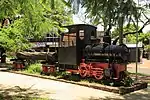 | 0-4-0 | 600 mm (1 ft 11+5⁄8 in) | 20 hp | Forest railway locomotive on the grass verge of Avenida Mitre between Avenida López Torres and Calle 25 de Mayo in Posadas, Argentina. The cow-catcher is probably based on the imagination of the erectors. The driver's cab also seems to be a simplified replica. |
| 1767 | 1905 | 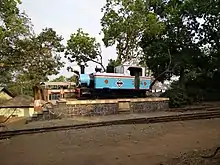 | 610 mm (2 ft) | Matheran Hill Railway | ||
| 1775 | 1906 | .jpg.webp) | 0-4-2 | 610 mm (2 ft) | 50 hp | No. 1 South-Western Railway Company, Knysna, South Africa[37] |
| 1779 | 1906 |  | 0-4-2 | 600 mm (1 ft 11+5⁄8 in) | 40 hp | Stock, Cairo, later South-Western Railway, Knysna, South Africa |
| 1786 | 1905 | .jpg.webp) | 0-4-4-0 Mallet | 600 mm (1 ft 11+5⁄8 in) | 80 hp | Pesantren 150, PG Pesantren Baru, Kediri, Indonesia |
| 1878 | 1906 | 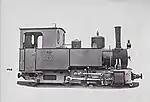 | 600 mm (1 ft 11+5⁄8 in) | Built for Caminho de Ferro Mossamedes, Angola | ||
| 1787 | 1905 | .jpg.webp) | 0-4-4-0 Mallet | 600 mm (1 ft 11+5⁄8 in) | 80 hp | Pesantren 151, PG Pesantren Baru, Kediri, Indonesia |
| 1847 | 1906 | .jpg.webp) | 4-4-0 | 891 mm (2 ft 11+3⁄32 in) (Swedish 3 ft gauge) | Der Kaiser, initially Borgholm–Böda Järnväg BBJ No 3, later Ölands Järnväg ÖJ No 9, since 1947 SJ w3p 3059, scrapped in 1953[38][39] | |
| 1870–1875, 2069–2070, 2356–2361, 2731–2734, 3182–3184, 4198–4199 | 1906–1910 | _ex_DSWA.jpg.webp) | 0-8-0 1'Dnv2t (No. 1-6) 1'Dn2t (others) | 1,067 mm (3 ft 6 in) | Lüderitz Bay Railway and South African Railways | |
| 1935 | 1906 |  | 0-6-0T | 710 mm | 140 hp or 160 hp | Ordered and possibly designed by Freudenstein for the Ricken Tunnel construction in Switzerland. Freudenstein had ceased building locomotives in 1905. According to O&K records, it was 140 HP (not 160 as in the catalogue), and it carried the name Wattwil |
| 2029 | 1906 |  | 0-4-0T | 600 mm (1 ft 11+5⁄8 in) | 20 hp |
LVD1, Parada Sud Quarry near Pueblo Centenario.[40] Hanko & Co, Argentina, preserved by Círculo de Estudios Ferroviarios del Uruguay (CEFU) at the Railway Museum in Montevideo Central Station, Uruguay, ex Lucas José Obes |
| 2046 | 1906 | .jpg.webp) | 0-4-0 | 600 mm (1 ft 11+5⁄8 in) | Used by ASEA for the construction of the northern part of the Lidingöbanan | |
| 2053 | 1906 | .jpg.webp) | 0-4-0 | 600 mm (1 ft 11+5⁄8 in) | 40 hp | Frankfurter Feldbahnmuseum No. 4 |
| 2076 | 1906 | .jpg.webp) | 0-4-0 | 600 mm (1 ft 11+5⁄8 in) | 40 hp | Used by ASEA for the construction of the Lidingöbanan |
| 2098 | 1906 | .jpg.webp) | 0-4-4-0 Mallet | 600 mm (1 ft 11+5⁄8 in) | 30 hp | Wonolangan 7, PG Wonolangan, Probolinggo, Indonesia |
| 2128 | 1906 | _and_-2128_from_1906_(via_Hermann_Sommer)._The_mill_was_dynamited_in_1913_during_the_Mexican_revolution.jpg.webp) | 0-6-0 | 2 ft (610 mm) | Hacienda Tenextepango, Morelos, Mexico, 24 inch 0-6-0's O&K works Nos. 1403-4/1905 (delivered via Arthur Koppel) and 2128/1906 (via Hermann Sommer). The mill was dynamited in 1913 during the Mexican revolution | |
| 2220 | .jpg.webp) | 0-4-2 | 1,067 mm (3 ft 6 in) | Khartum–Wadi Halfa railway | ||
| 2240 | 1907 | .jpg.webp) | 0-6-0 | 610 mm (2 ft) | 100PS | No. 2 South-Western Railway Company, Knysna, South Africa[37] |
| 2271 | 1907 | .jpg.webp) | 0-4-0 | 610 mm (2 ft) | 30 hp | Initially Public Works Department of Victoria, land reclamation work at the Coode Canal, Port Melbourne, later Western Australian Public Works Department, Point Samson–Roebourne[23] |
| 2303 | 1907 | .jpg.webp) | 0-4-0 | 610 mm (2 ft) | 30 hp | Harvey, Western Australia (see also No 2271/1997) |
| 2342 | 1907 |  | 0-6-0 | 610 mm (2 ft) | 150 hp | 739 Matheran, Matheran Hill Railway, now National Rail Museum of India, New Delhi. |
| 2343 | 1907 |  | 0-6-0 | 610 mm (2 ft) | 150 hp | 740 Matheran, Matheran Hill Railway, now Leighton Buzzard Light Railway |
| 2378 | 1907 |  | 0-4-0 | 600 mm (1 ft 11+5⁄8 in) | 30 hp | Utrillas, Lancashire Mining Museum (West Lancashire Light Railway until 2021) |
| 2424 | 1907 | .jpg.webp) | 0-4-0 | 600 mm (1 ft 11+5⁄8 in) | 20 hp | Similar to 2461/1907. Whim Creek Copper Mine near City of Karratha, Western Australia.[23] |
| 1907 |  | 0-8-0 | Naters, Switzerland | |||
| 2346 | 1907 | _or_N%C2%B0_3247_20hp_(1909)%252C_property_of_Hacienda_San_Nicol%C3%A1s_del_Monte_'Chaparro'%252C_Michoac%C3%A1n%252C_Mexico_(Ubaldo_de_Agostil%C3%A1n_Mar%C3%ADn's_archive)_01.jpg.webp) | 0-6-0 | 600 mm (1 ft 11+5⁄8 in) | 20 hp | Hacienda San Nicolás del Monte Chaparro, Michoacán, Mexico |
| 2413-2416 |  | 0-8-0 | Loetschberg №42, Switzerland | |||
| 2448 | 1908 | _im_Einsatz_auf_der_Seite_Brig%252C_Kreuzung_von_Geleise_II_mit_Schmalspur%252C_1913-1914._In_Simplontunnel_II%252C_1913-1921.jpg.webp) | 0-4-0 | Delivered to Lötschbergbahn as a construction locomotive, later probably Simplon No. 4, used at Brig during the construction of the Simplon Tunnel | ||
| 2475 | 1907 | .jpg.webp) | 0-4-0 | 600 mm (1 ft 11+5⁄8 in) | Fia, № 1, Aspa Bruk (Ägare Munksjö AB), Sweden[41] | |
| 2525 |  | 0-4-0 | 891 mm (2 ft 11+3⁄32 in) (Swedish 3 ft gauge) | Skånska Järnvägar | ||
| 2595 | 1907 |  | 0-6-0 | 1,435 mm (4 ft 8+1⁄2 in) | 300 hp | Ferrovia Valle Brembana |
| 2604 | 1907 |  | 0-6-0 | 1,000 mm (3 ft 3+3⁄8 in) | 150 hp | Cochin State Forest Tramway |
| 2609 | 1907 |  | 0-4-4-0 Mallet | 610 mm (2 ft) | 110 hp | Orenstein & Koppel Ltd, London-Berlin, General-Agents, The ‚Central' Mining & Tramway Appliances Proprietary Ltd 40, Hunter Street, Sydney[42] Magnet Tramway, now Bennett Brook Railway |
| 2641 | 1907 |  | 0-4-0 | 750 mm (2 ft 5+1⁄2 in) | Union Bergb. Wien (1907–), Rheinregulierungsbahn Steffi (1937–), now Technisches Museum, TMW-Depot Marchegg | |
| 2649 | 1908 |  | 0-4-0 | 600 mm (1 ft 11+5⁄8 in) | 40 hp | Tacot des Lacs |
| ca 1908 | .webp.png.webp) | 0-4-0 | 600 mm (1 ft 11+5⁄8 in) | Taube (pigeon), the US army conficated the German locomotive in World War I near Cierges in France | ||
| 2677 | 1907 |  | 0-8-0 | 750 mm (2 ft 5+1⁄2 in) | 200 hp | Loetschberg N° 32, compressed air locomotive |
| 2681 | 1907 | .jpg.webp) | 0-4-0 | 1,000 mm (3 ft 3+3⁄8 in) | 20 hp | Bauru, São Paulo, Brazil |
| 2697 | 1908 | .jpg.webp) | 600 mm (1 ft 11+5⁄8 in) | Moortje, Efteling Stoomtrein Maatschappij, near Kaatsheuvel between Waalwijk and Tilburg, Netherlands | ||
| 2728 | 1908 | 0-4-4-0 Mallet | 600 mm (1 ft 11+5⁄8 in) | 60 hp | Rejo Agung 23 PonenII, PG Rejo Agung, Madiun, Indonesia (See also: N° 4494/1910) | |
| 2738 | 1908 |  | 0-6-0 | 1,435 mm (4 ft 8+1⁄2 in) | 350 hp | Valsugana, Italy, Ferrovie Valsugana N° 4, since 1912 FS 87 161 |
| 2748 | .jpg.webp) | 610 mm (2 ft) | Dunkley Brothers, North East Dundas Tramway | |||
| 2762 | 1907 | .jpg.webp) | 0-8-0 | 600 mm (1 ft 11+5⁄8 in) | 35 hp | PG Tulungagung 1, Mojopanggung, Java, Indonesia |
| 2797 | 1908 | _1_(22571300823).jpg.webp) | 0-4-4-0 Mallet | 600 mm (1 ft 11+5⁄8 in) | 80 hp | Initially Compania Minera de Torreon, Mexico, later Cia. Minera de Penoles-Avalos, Mexico, since 1964 № 1, Cripple Creek and Victor Narrow Gauge Railroad, Colorado, USA |
| 2903 and 2904 | 1908 |  | 0-4-0 | 600 mm (1 ft 11+5⁄8 in) | 30 hp | SA & Ind Forestali, Bibbiena, Italy |
| 2966 | 1908 | .jpg.webp) | 0-4-2 | 600 mm (1 ft 11+5⁄8 in) | 40 hp | De Maas 4, PG De Maas, Besuki, Indonesia |
| 2967 | 1908 | .jpg.webp) | 0-4-2 | 600 mm (1 ft 11+5⁄8 in) | Lumajang, PG Jatiroto, Indonesia | |
| 3009 | 1908 | 0-6-0 | 600 mm (1 ft 11+5⁄8 in) | 140 hpi | KKP No 1, Kleinbahn Klockow–Pasewalk, since 1950 DR 99 4612[43][44] | |
| 3010 | 1908 |  | 0-6-0 | 600 mm (1 ft 11+5⁄8 in) | 140 hpi | KKP No 2, Kleinbahn Klockow–Pasewalk, since 1950 DR 99 99 4613[43][44] |
| 3019 | 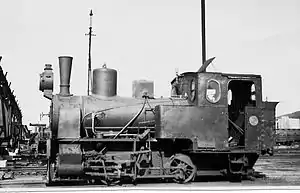 | 0-4-2 | Initially Hollandse Anneming Maatschappij, later harbour locomotive of SA Railways in Paardeneiland, Cape Town | |||
| 3053 | 1908 | 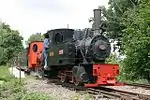 | 0-4-0 | 600 mm (1 ft 11+5⁄8 in) | Dampf 50 hp | Aquilla, initially Wuytack de Gand, Belgium, later S. A. de Beton Belges, then Rail Rebecq Rognon[45] |
| 3111-3112 | 1909 |  | 0-6-0 | 1,435 mm (4 ft 8+1⁄2 in) | 350 hp | Becker & Co for secondary railway Friedeberg-Flinsberg |
| 3127 |  | Gerald & Lorna Dee Collection, Museums Victoria | ||||
| 3136 | 1908 | 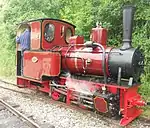 | 0-4-0 | 600 mm (1 ft 11+5⁄8 in) or 610 mm (2 ft) | 40 hp | Amberley Museum Railway |
| 3161-3163 | 1908 | .jpg.webp) | 0-4-0 | 600 mm (1 ft 11+5⁄8 in) | 40 hp | Island of Angaur in German New Guinea, from 1918 Nanyo-Agency (南洋庁) in the Japanese South Seas Mandate. The following 600 mm (1 ft 11+5⁄8 in) gauge O&K locomotives were supplied to Deutsche Südseephosphat AG, Angaur: Nos 3161, 3162 & 3163 in 1908, No 4236 in 1910 and No 4783 in 1911. |
| 3174 | 1908 | .jpg.webp) | 0-6-0 | 600 mm (1 ft 11+5⁄8 in) | Ortal Group K6, Tramways du Lot-et-Garonne, Tonneins, France[46] | |
| 3216 | 1908 | .jpg.webp) | 0-4-0 | 900 mm | 90 hp | Unterengstringen ZH, gravel pit Kieswerk am Hardwald, Dietikon, Switzerland |
| 3247 | 1909 | _or_N%C2%B0_3247_20hp_(1909)%252C_property_of_Hacienda_San_Nicol%C3%A1s_del_Monte_'Chaparro'%252C_Michoac%C3%A1n%252C_Mexico_(Ubaldo_de_Agostil%C3%A1n_Mar%C3%ADn's_archive)_02.jpg.webp) | 0-6-0 | 600 mm (1 ft 11+5⁄8 in) | 20 hp | Hacienda San Nicolás del Monte Chaparro, Michoacán, Mexico |
| 3248 | 1909 | _in_front_of_'Dunstanburgh'_(Jung_812_of_1904).png.webp) | 0-4-0 | 600 mm (1 ft 11+5⁄8 in) | Railway from Embleton Quarry to Christon Bank station and to the small harbour at Craster, Northumberland, Fanny Gray (O&K 3248/1909) in front of Dunstanburgh (Jung 812/1904) | |
| 3377 | 1908 | %252C_jetzt_DR_994531%252C_'Gl%C3%BCckauf'.png.webp) | 0-8-0 | 750 mm (2 ft 5+1⁄2 in) | Glückauf, Trusebahn, later DR 994531 | |
| 1430 | 1908 |  | 0-8-0 | 785 mm (2 ft 6+29⁄32 in) | 200 hp | Kattowitz II. The Urskog–Hølandsbanen from Sørumsand to Skulerud in Norway (750 mm (2 ft 5+1⁄2 in) gauge) got an offer for an O&K locomotive like the one, but never bought it. |
| 3310 | 1909 | .jpg.webp) | 0-6-0 | 610 mm (2 ft) | 60 hp | German Annie, № 4, Proserpine Central Mill Co Ltd, Queensland, Australia[23] |
| 3311 | 1909 |  | C'1 n2t | 610 mm (2 ft) | 120 hp | Kaiser, Gin Gin Central Mill Co Ltd, Wallaville, Queensland, Australia[23] |
| 3317 | 1909 | .jpg.webp) | 0-4-2 | 610 mm (2 ft) | 40 hp | Jatiroto 23J, Lumajang, PG Jatiroto, Indonesia |
| 3324 | 1909 | %252C_geliefert_1909._Fabrik_wurde_1834_in_Betrieb_genommen_in_Nederlands-Indi%C3%AB_(heute_Indonesien).jpg.webp) | Sugar mill Ketanen, Modjokerto, East Java, Dutch East Indies (now Indonesia) | |||
| 3325 | 1909 |  | Sugar mill Ketanen, Modjokerto, East Java, Dutch East Indies (now Indonesia) | |||
| 3358 | 1909 |  | 0-3-0 | Monorail locomotive (Ewing System) | Patiala State Monorail Tramways, now National Rail Museum of India, New Delhi. The locomotive's three wheels run with double wheel flanges on a steel rail laid along a road and transfer about 95% of the weight. A support wheel prevents the locomotive from tipping over. | |
| 3362 | 1909 | 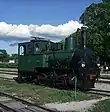 | 0-4-0T | 900 mm or 891 mm | 140 hp | H. Weber, Unnam, construction of the Osterfeld-Hamm railway delivered to Datteln Skanska Cement AB Schweden, later Limhama, preserved as Cementa, N° 16 at Hesselby Jernvägar, Gotland, Sweden |
| 3452 | 1910 |  | 0-4-4-0 Mallet | 80 hp | Compagnie de l'Union in Mazaugues, France | |
| 3475 | 1909 |  | 0-4-0T FL | 500 mm (19+3⁄4 in) | 30 hp | S.A. minière et industrielle Domsgrube near Jaworzno, fireless locomotive similar to 4464/1910, 4465/1910 and 5150/1911 |
| 3488 | 1909 |  | 0-4-0T+T | 600 mm (1 ft 11+5⁄8 in) | 30 hp | Delivered to Genietroepen, Utrecht for Kamp van Zeist, Netherlands |
| 3493 | 1909 |  | 2-4-0T+T | 750 mm (2 ft 5+1⁄2 in) | 50 hp | The Borneo Co. Ltd. in Lampang in Siam |
| 3498 | 1909 | 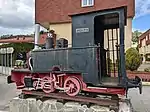 | 0-4-0 | 600 mm (1 ft 11+5⁄8 in) | 20 hp | Anita № 6, Mines at Dícido, Mioño, Spain |
| 3509 |  | 0-6-0 | ||||
| 3558 | 1909 | .jpg.webp) | 0-4-0 | 600 mm (1 ft 11+5⁄8 in) | 30 hp | Kimberley, The Basset Mines Ltd, Illogan, England |
| 3724 | .jpg.webp) | 0-4-0 | Bei Drabo in Östergötland, Sweden | |||
| 3753 | 1909 | .jpg.webp) | 0-8-0 | 600 mm (1 ft 11+5⁄8 in) | 60 hp | Pagottan 1, PG Pagottan, Madiun, Indonesia |
| 3771 | 1909 | .jpg.webp) | 0-6-0 | 610 mm (2 ft) | 50 hp | Goodwood Tramway, Kalgoorlie and Boulder Firewood Co, Beria, Western Australia[23] |
| 3892 | 1910 | Replacement boiler for K. Pautzmann brick works, Gundorf near Leipzig | ||||
| 3789 | 1910 | .jpg.webp) | 0-8-0 | 600 mm (1 ft 11+5⁄8 in) | 100 hp | Kanigoro Nr. 5, PG Kanigoro, Madiun, Indonesia |
| 3902 | 1909 | .jpg.webp) | 0-4-4-0 Mallet | 600 mm (1 ft 11+5⁄8 in) | 30 hp | Frankfurter Feldbahnmuseum No 13 |
| 3904 | _(20183411063).jpg.webp) | 2-4-0 | From Orenstein-Arthur Koppel Company, 30 Church St., New York via Schwab & Tillmann, agent for Cuba, San Ignacio 76, Habana to Central dos Amigos,[47] | |||
| 3939 | 1910 |  | 0-6-6-0 Mallet | 1,000 mm (3 ft 3+3⁄8 in) | 500 hp | 55 t, NWE N° 31 of Nordhausen-Wernigeroder Eisenbahn-Gesellschaft for Brocken Railway |
| 3940 | 1910 |  | 0-6-6-0 Mallet | 1,000 mm (3 ft 3+3⁄8 in) | 500 hp | 55 t, NWE N° 32 Nordhausen-Wernigeroder Eisenbahn-Gesellschaft for Brocken Railway |
| 3973 | 1910 | %252C_page_144%252C_Fig_13776%252C_FCNC_N%C2%B0_23%252C_O%2526K_locomotive_with_six_wheeled_tender%252C_500_hp%252C_metre_gauge%252C_service_weight_69_tons_with_tender%252C_supplied_to_the_Chilian_Northern_Railways.jpg.webp) | 2-6-0 | 1,000 mm (3 ft 3+3⁄8 in) | 350 hp | Tacna–Arica railway, Direccion de Obras Publicas, Santiago N° 23, service weight 69 tons with tender |
| 3980 | 1910 |  | 0-8-0 | 760 mm (2 ft 5+15⁄16 in) | 80 hp | Initially Toth Mihaly, Budapest, later 764.211, then 6110 Rachita Museum Satului, Bukarest, since 2004 Măriuța, Mocăniță pe traseul CFF Vișeu, Romania |
| 3952 | 1910 | .jpg.webp) | 0-8-0 | 600 mm (1 ft 11+5⁄8 in) | 100 hp | Purwodadi 8, PG Purwodadi, Ngawi, Indonesia |
| ca 1910 |  | Theo, Sugar mill Tjoekir in Jombang, Indonesia | ||||
| 3961 | 1910 |  | 0-8-0 | 610 mm (2 ft) | 50 hp | Goodwood Timber and Tramway Co Ltd, Port Albert, Victoria, Australia[23] |
| 3999 | 1910 | .jpg.webp) | 0-6-0 | 600 mm (1 ft 11+5⁄8 in) | Ortal Group K4, Tramways du Lot-et-Garonne, Tonneins, France[46] | |
| 4011 | 1910 | .jpg.webp) | 0-6-0 | 600 mm (1 ft 11+5⁄8 in) | 20 hp | Ferrocarril Austral Fueguino, El Tren del Fin del Mundo, now plinted at the jail of Ushuaia |
| 4017 | 1910 |  | 0-4-0 | Initially 600 mm (1 ft 11+5⁄8 in), later 1,000 mm (3 ft 3+3⁄8 in) | 20 hp | FC Midland de Buenos Aires and Talleres Libertad, later Domingo Faustino Sarmiento Railway X-5, now Plaza Once, Buenos Aires, Argentina[48] |
| 4028 |  | 600 mm (1 ft 11+5⁄8 in) | Makatea, Tuamotu, French Polynesia | |||
| 4058 | 1910 |  | 0-4-0 | Carnarvon Tramway, Western Australia[49] | ||
| 4083 | 1910 |  | 0-4-0 | 600 mm (1 ft 11+5⁄8 in) | 40 hp | Münster |
| 4115 | 1910 |  | 0-8-0T | 750 mm (2 ft 5+1⁄2 in) | 40 hp | Lovcen, BAr/Virpazar, Montenegro, now on display at Podgorica station |
| 4134 | 1910 | .jpg.webp) | 0-4-0+t | 750 mm (2 ft 5+1⁄2 in) | Cornellá, No 14, Narrow gauge railway Palamós–Girona–Banyoles and later narrow gauge railway Valdepeñas–Puertollano[50] | |
| 4135 | 1910 | .jpg.webp) | 0-4-0+t | 750 mm (2 ft 5+1⁄2 in) | Mercedes, No 15, Narrow gauge railway Palamós–Girona–Banyoles and later narrow gauge railway Valdepeñas–Puertollano[50] | |
| 4201 | 1910 | _with_the_Aldama_Sugar_Mill_(24in)%252C_Puebla%252C_Mexico%252C_4-6-0_FCI_%E2%84%96264_(Baldwin_%E2%84%9615749_of_Feb_1898)%252C_and_2-6-0_Ingenio_Tilapa_%E2%84%961_(O%2526K_%E2%84%964201_of_1910)%252C_retouched.jpg.webp) | 2-6-0 | 2 ft (610 mm) | Ingenio Tilapa №1, Aldama Sugar Mill, Puebla, Mexico | |
| 4202 | 1910 | _from_1910%252C_24in%252C_delivered_to_Leandro_Aldama_for_Tilapa_Sugar_Mill%252C_Aldama%252C_Puebla%252C_Mexico_(Linwood_W._Moody_-_The_Maine_Two-Footers).jpg.webp) | 2-6-0 | 2 ft (610 mm) | Ingenio Tilapa №2, Aldama Sugar Mill, Puebla, Mexico | |
| 4244 | 1910 | .jpg.webp) | 0-8-0 | 600 mm (1 ft 11+5⁄8 in) | 60 hp | Pagottan 2, PG Pagottan, Madiun, Indonesia |
| 4264 | 1910 | .jpg.webp) | 0-8-0 | 600 mm (1 ft 11+5⁄8 in) | 60 hp | Kanigoro 2, Madiun, Java, Indonesia |
| 4300 | 1910 | .jpg.webp) | 0-8-0 | 600 mm (1 ft 11+5⁄8 in) | 60 hp | Olean 7, PG Olean, Situbondo, Indonesia |
| 4360 | 1910 | .jpg.webp) | 0-8-0 | 600 mm (1 ft 11+5⁄8 in) | 60 hp | Olean 2, PG Olean, Situbondo, Indonesia |
| 4400 | 1910 | .jpg.webp) | 0-8-0 | 600 mm (1 ft 11+5⁄8 in) | 60PS | Kebonagung 2, PG Kebonagung, Malang, Indonesia |
| 4403 | 1911 |  | 0-6-0 | 1,435 mm (4 ft 8+1⁄2 in) | Preußische Staatsbahn, Gattung T3, N° 89 6143 | |
| 4445 | 1910 | .jpg.webp) | 0-8-0 | 600 mm (1 ft 11+5⁄8 in) | 60 hp | Purwodadi 10, PG Purwodadi, Ngawi, Indonesia |
| 1910 |  | 0-6-0 | 1,000 mm (3 ft 3+3⁄8 in) | Nr. 59. Initially Ferrocarriles del Estado and a construction company of Santiago del Estero, later Tranway Rural Reconquista[51] | ||
| 1910 | 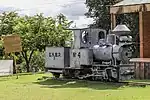 | 0-4-0 | 40 hp | Initially Isnardi Alves & Cia, since 1913 Cia. Matte Laranjeira at Estrada de Ferro Guairá a Porto Mendes, since 1944 N° 4 of Serviço de Navegação da Bacia do Prata (SNBP), operational until 1959 or 1916, now exhibited at Guaíra, Paraná, Brazil | ||
| 4614-4621 | 1911 | 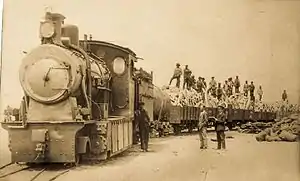 | 1'Dn2 | 1,067 mm (3 ft 6 in) | Lüderitz Bay Railway and South African Railways | |
| 4623 | 1911 | .jpg.webp) | 0-6-0 | Initially 750 mm (2 ft 5+1⁄2 in), later 914 mm (3 ft) | 60 hp | First locomotive of the FCCSA, preserved at Estación Wánchaq, Cuzco, Peru |
| 4631 | 1911 |  | Bn2t | 762 mm (2 ft 6 in) | Grafton Copper Mining Co in Cangai near Grafton in New South Wales, Australia | |
| 4359 | 1910 | .jpg.webp) | 0-8-0 | 600 mm (1 ft 11+5⁄8 in) | 60 hp | Purwodadi 16, PG Purwodadi, Ngawi, Indonesia |
| 4494 | 1910 | .jpg.webp) | 0-4-4-0 Mallet | 600 mm (1 ft 11+5⁄8 in) | 60 hp | Rejoagung № 23 PonenII[52][53] (see also No 2728/1908) |
| 4676 | 1911 |  | 0-4-0 | 1,067 mm (3 ft 6 in) | 30 hp | Mizuma Town, Kurume, Fukuoka, Japan |
| 4698-4700 | 1911 |  | Japan[54] | |||
| 4720 | 1911 | 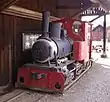 | 0-4-0 | 750 mm (2 ft 5+1⁄2 in) | 30 hp | Initially Usines Carrières de Vaujours et Livry-Gargan, later Roche-sur-Foron, Haute Savoie, now Stefanie, Chemin de fer touristique d'Abreschviller |
| 4768 | 1912 |  | 0-8-0 | 1,435 mm (4 ft 8+1⁄2 in) | 500 hp | Société Ané d'Eronville à Crusnes, France, Gölsdorf axles, secondary railway Bossel-Blankenstein N° 3, since 1926 Marburger Kreisbahn N° 5, since 1933 Grube Anna, Alsdorf |
| 4819 | 1912 |  | Delivered to Francisco Brunet Manati. The lettering "Orenstein & Arthur Koppel, Comp. Berlin-Nueva York, Agentes Generales para la usla de Puerto-Rico, Koerber & Co, San Juan" is unusual. O&K delivered only 19 locomotives to Puerto Rico, and the name Koerber does not appear in the delivery lists. Orenstein & Koppel - Arthur Koppel was otherwise used. | |||
| 4843 | 1911 |  | 0-4-0 | 762 mm (2 ft 6 in) | 60 hp | Port Kunda Cement Factory, now preserved at Estonian Railway Museum, Lavassaare, Estonia |
| 4863 | 1911 | .jpg.webp) | 0-8-0 | 600 mm (1 ft 11+5⁄8 in) | 60 hp | Gempolkerep 15, Mojokerto, Indonesia |
| 4868 | 1911 | .jpg.webp) | 0-8-0 | 600 mm (1 ft 11+5⁄8 in) | 60 hp | Asembagus 16 Slamet, Asembagus, Situbondo, Indonesia |
| 4870 | 1911 | .jpg.webp) | 0-8-0 | 600 mm (1 ft 11+5⁄8 in) | 60 hp | Wringinanom 6, PG Wringinanom, Situbondo, Indonesia |
| 4880 | 1911 | .jpg.webp) | 0-8-0 | 610 mm (2 ft) | South-Western Railway Company, Knysna, South Africa[37] | |
| 4930 | 1911 |  | 0-4-0 | 600 mm (1 ft 11+5⁄8 in) | 30 hp | Initially Wegerif, Amsterdam, later brick works Ijsseloord, Arnhem, Netherlands, since 1968 Aagje, Efteling Stoomtrein Maatschappij, near Kaatsheuvel between Waalwijk and Tilburg, Netherlands |
| 4987 | 1920 |  | 0-6-0 | 1,000 mm (3 ft 3+3⁄8 in) | 60 hp | Diss & Co, Puerto de Adra, Spain |
| 4990 | 1911 | .jpg.webp) | 0-8-0 | 600 mm (1 ft 11+5⁄8 in) | 60 hp | Wonolangan 2, PG Wonolangan, Probolinggo, Indonesia |
| 4991 | 1911 | .jpg.webp) | 0-4-4-0 Mallet | 600 mm (1 ft 11+5⁄8 in) | 80 hp | Asembagus 8, Asembagus, Situbondo, Indonesia |
| 5020 | 1911 | 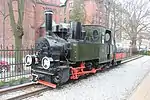 | 0-8-0 | 600 mm (1 ft 11+5⁄8 in) | Tx2-355, Narrow Gauge Railway Museum in Wenecja, Poland,[55] now Plac Strzelecki, Wroclaw | |
| 5081 | 1911 | .jpg.webp) | 0-6-2 | 508 mm (1 ft 8 in) | 50 hp | The Sons of Gwalia Ltd, Leonora, Western Australia, Koppel[23] |
| 5102 | 1912 | .jpg.webp) | 0-4-0 | 914 mm (3 ft) | 140 hp | Poldark Mine bei Wendron, Cornwall |
| 5152 | 1911 | .jpg.webp) | 0-8-0 | 600 mm (1 ft 11+5⁄8 in) | 80 hp | Kanigoro 4, PG Kanigoro, Madiun, Indonesia |
| 5168 | 1911 | %252C_page_143%252C_Fig_15038%252C_Central_Alianza_Camuy_P.R.%252C_N%C2%B0_2%252C_O%2526K_six_wheel_coupled_locomotive%252C_110_hp%252C_with_radial_axles_for_2ft_6_in_gauge_with_4_wheeled_tender.jpg.webp) | 0-6-0T+T | 762 mm (2 ft 6 in) | 110 hp | Central Alianza Arcibo & Camry N° 2, Puerto Rico |
| 5175 | 1912 | .jpg.webp) | 0-8-0 | 700 mm (2 ft 3+9⁄16 in) | Ingenio Ledesma, Argentina|- | |
| 5179 | 1912 |  | 0-4-0 | 600 mm (1 ft 11+5⁄8 in) | 50 hp | Katharina, Moor- und Fehnmuseum Elisabethfehn in Barßel, Germany |
| ca 1912 |  | 0-4-0 | 750 mm (2 ft 5+1⁄2 in) | 50 hp | ||
| 5199 | 1911 | .jpg.webp) | 0-8-0 | 600 mm (1 ft 11+5⁄8 in) | 60 hp | Rendeng 02, PG Rendeng, Kudus, Indonesia |
| 5200 | 1911 |  | 0-4-0 FL | 600 mm (1 ft 11+5⁄8 in) | 60 hp | Fireless locomotive of the municipal drinking water supply pipeline of Rotterdam,[56] |
| 5201-5212 | 1912 | %252C_page_144%252C_Fig_10043%252C_Mogul_locomotive_with_six_wheel_tender%252C_350_hp%252C_metre_gauge%252C_service_weight_40_plus_20_tons%252C_supplied_ot_Chilian_State_Railway.jpg.webp) | 2-6-0 | 1,000 mm (3 ft 3+3⁄8 in) | 350 hp | Chilean Longitudinal Railway N° 21-32 |
| 5217 | 1912 | .jpg.webp) | 0-8-0 | 600 mm (1 ft 11+5⁄8 in) | 60 hp | Gempolkerep 14, Mojokerto, Indonesia |
| 5297 | 1912 | 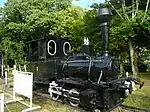 | 0-4-0 | 1,067 mm (3 ft 6 in) | 40 hp | Miyazaki Kotsu Railway SL No 1 (1913–1962), now JR Lyushu Nichinan Line |
| 5301–5305 | 1912 | 20 hp | Delivered to Argentina. The main dimensions changed in 1912 from 145 mm × 260 mm cylinders and 900 mm axle distance (Alte Normalien, old standard) to 150 mm × 275 mm cylinders and 1200 mm axle distance (Neue Normalien, new standard) | |||
| 5335 | 1912 | 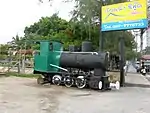 | 0-6-0 | 750 mm (2 ft 5+1⁄2 in) | 80 hp | Sri Maharacha Timber Company SRJ, Si Racha, SRJ 6, now Surasak Montri Public Park, Si Racha Thailand |
| 5414 | 1912 |  | 0-6-0 | 1,435 mm (4 ft 8+1⁄2 in) | 350 hp | Municipal Construction Office, Duisburg, since 1924 Marburger Kreisbahn N°4, since 1954 AG Aufbau, Allendorf |
| 5438 | 1912 | .jpg.webp) | 0-8-0 | 600 mm (1 ft 11+5⁄8 in) | 60 hp | Merapi 15, Asembagus, Situbondo, Indonesia |
| 5440 | 1912 | .jpg.webp) | 0-4-0 | 600 mm (1 ft 11+5⁄8 in) | 60 hp | Olean 4, PG Olean, Situbondo, Indonesia |
| 5343 | 1912 | .jpg.webp) | D n2 | 2 ft (610 mm) | 100 hp | N° 4 ‘ASPILLAGA’, 100 hp, ordered for Hacienda Cayalti in Cayalti District, Región de Lambayeque, Peru |
| 5455 | 1912 | %252C_page_143%252C_Fig_13881%252C_Estrada_de_Ferro_Funilense%252C_N%C2%B0_8_O%2526K_eight_wheel_coupled_locomotive%252C_250_hp%252C_metre_gauge%252C_service_weight_26_plus_17_tons%252C_supplied_for_a_railway_in_Brazil.jpg.webp) | 0-4-0 | 1,000 mm (3 ft 3+3⁄8 in) | 250 hp | Funilense E.B., Sao Paulo, 4 axle tender, Estrada de Ferro Funilense, N° 8, service weight 26 plus 17 tons |
| 5605 | 1912 |  | 0-4-0 | 600 mm (1 ft 11+5⁄8 in) | 40 hp | N° 2, Kapsa & Müller, Prague |
| ca 1912 | .jpg.webp) | 0-4-0 | 600 mm (1 ft 11+5⁄8 in) | 20 hp | 2-2 coupled tender locomotive, 5.4 tonnes (5.3 long tons; 6.0 short tons) used at the Battles of the Isonzo, 25 May 1918 | |
| ca 1912 |  | 0-4-0 | 600 mm (1 ft 11+5⁄8 in) | 20 hp | Constructor's locomotive of E. Blok, Rotterdam | |
| 5658 | 1912 | .jpg.webp) | 0-4-0 | 600 mm (1 ft 11+5⁄8 in) | Stockholms Elektricitetsverk, Untraverket 1, 1916 decommissioned, since 1917 Vattenfall CF 10, decommissioned 1952.[57] | |
| 5662 | 1912 | 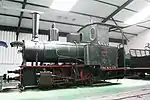 | 0-4-0 | 600 mm (1 ft 11+5⁄8 in) | 50 hp | Initially Argentina, now Apedale Valley Light Railway. After leaving Statfold Barn Railway for a private site in Whaley Bridge in 2013, it came to Apedale in May 2022 after a full restoration to steam. The original livery from Argentina has been retained by the owners, and it is paired with a tender from its time in Argentina. It will be based at Apedale for the foreseeable future and will operate occasionally on passenger trains throughout the year. |
| 5668 | 1913 | 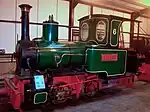 | 0-4-0 | 600 mm (1 ft 11+5⁄8 in) or 610 mm (2 ft) | 30 hp | Initially Penrhyn Quarry Railway. 1963 sold to Bressingham Steam and Gardens'. Since 1995 at Bredgar and Wormshill Light Railway.[58] |
| 5672 | 1912 | .jpg.webp) | 0-6-0 | 600 mm (1 ft 11+5⁄8 in) | Petter, No 1, Lindfors-Bosjöns Järnväg[59][60] | |
| 5745 | 1912 | .jpg.webp) | 0-4-0 | 600 mm (1 ft 11+5⁄8 in) | 20 hp | Initially Ferrocarriles en el cono sur FCS (Argentina), now Chapel Hydraulique GmbH, Kimmerle-Ring, Günzburg, Germany |
| 5754 | 1913 |  | 2-6-0 | 1,000 mm (3 ft 3+3⁄8 in) | 200 hp | E 94, Vale de Vouga, Comboios de Portugal, Portugal |
| 5755 | 1912 |  | 2-6-0 | 1,000 mm (3 ft 3+3⁄8 in) | 200 hp | E 96, Decauville-Locomotive No. 5755/1913, Vale de Vouga, Comboios de Portugal, Portugal, now Musée des tramways à vapeur et des chemins de fer secondaires français in Butry-sur-Oise in département Val-d'Oise, 30 kilometres (19 mi) north of Paris |
| 5756 | 1913 |  | 2-6-0 | 1,000 mm (3 ft 3+3⁄8 in) | 200 hp | Companhia Real dos Caminhos de Ferro Portuguese E 91, Vale de Vouga, Comboios de Portugal, Portugal |
| 5757 | 1913 |  | 2-6-0 | 1,000 mm (3 ft 3+3⁄8 in) | 200 hp | Companhia Real dos Caminhos de Ferro Portuguese E 97, Vale de Vouga, Comboios de Portugal, Portugal |
| 5805 | 1912 | 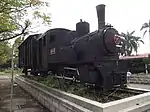 | 0-6-0 | 762 mm (2 ft 6 in) | 90 hp | No 201 of Japanese government railways, later LCK 31 of the Taiwaneses government railway, now plinthed in Hualien, Taiwan |
| 5744 | 1912 | .jpg.webp) | 0-4-0 | 600 mm (1 ft 11+5⁄8 in) | Initially Obras de Irrigacion del Territoria del Rio Negro, later Moño Azul, near Vista Alegre Sur and Centenario, Neuquén, Argentina, now Rebecca, Devon Railway Centre, Bickleigh, Devon, England[61] | |
| 5829 | 1913 |  | 0-4-0 | 600 mm (1 ft 11+5⁄8 in) | 50 hp | Train de Rillé |
| 5834 | 1913 | .jpg.webp) | 0-4-0 | 610 mm (2 ft) | 20 hp | No 11, P C Allen, weight: 5.57 tonnes. Was in service at a Solvay Alkali Plant in Torrelavega, Spain. Named after the chairman of ICI from 1968 to 1971, who was a light railway enthusiast and instigated the rescue of this locomotive. Now Leighton Buzzard Light Railway. |
| 5856 | 1912 | .jpg.webp) | 0-8-0 | 600 mm (1 ft 11+5⁄8 in) | 60 hp | Olean 1, PG Olean, Situbondo, Indonesia |
| 5857 | 1912 | .jpg.webp) | 0-8-0 | 600 mm (1 ft 11+5⁄8 in) | 60 hp | Sumberharjo 2, PG Sumberharjo, Pemalang, Indonesia |
| 5859 | 1912 | .jpg.webp) | 0-8-0 | 600 mm (1 ft 11+5⁄8 in) | 60 hp | Pesantren 9, PG Pesantren Baru, Kediri, Indonesia |
| 5885 | 1912 | 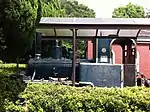 | 0-4-0 | 1,067 mm (3 ft 6 in) | 40 hp | Johoku Kotsu Park, Itabashi, Tokio, Japan |
| 5896 and 5897 | 1912 | .jpg.webp) | 0-8-0 | 600 mm (1 ft 11+5⁄8 in) | Nybergs Gruv AB 1 and Nybergs Gruv AB 2, Nyberget Morgårdshammar (Nybergets Järnväg NJ, Nybergs Gruv - Avesta Jernverks AB), Sweden[62] | |
| 5896 and 5897 | 1912 | %252C_Schweden.jpg.webp) | 0-8-0 | 600 mm (1 ft 11+5⁄8 in) | Nybergs Gruv AB 1 and Nybergs Gruv AB 2, Nyberget Morgårdshammar (Nybergets Järnväg NJ, Nybergs Gruv - Avesta Jernverks AB), Sweden[62] | |
| 5911 | 1913 |  | 0-6-0 | 1,435 mm (4 ft 8+1⁄2 in) | 650 hp | This was 5000th locomotive built by O&K, built in 1913 and delivered to the Royal Prussian State Railway Administration as G8 Bromberg 4823, according to a commemorative publication for the 5000th locomotive, later PKP Tp3-75 and DRB 55 1669. |
| 5933 | 1913 | .jpg.webp) | Putte was used from 1914 to 1934 between Båven and the Likstammen lake (Båven–Likstammen Järnväg, Axalabanan), Sweden | |||
| 5978 | 1913 |  | 0-4-0 | 700 mm (2 ft 3+9⁄16 in) - 750 mm (2 ft 5+1⁄2 in) | Speer, Hammel & Matten, Essen | |
| 5990 | 1912 |  | originally 0-4-0T, later 0-4-2T | 600 mm (1 ft 11+5⁄8 in) | 60 hp | Sold in 1912 to Decauville São Paulo (as an agent or reseller), later Craig & Martin Brasil, later Estrada de Ferro Perus – Pirapora – EFPP No. 8 (chemin de fer de Cimento Portland Perus – Cajamar), later converted to 0–6–2, now LP Assessoria Industrial e Restaurações Ltda. – Votorantim, SP[63][64] |
| 6008 | 1912 | .jpg.webp) | 0-4-4-0 Mallet | 600 mm (1 ft 11+5⁄8 in) | 60 hp | Candi 6, Sidoarjo, Indonesia |
.webp.png.webp) | 0-4-0 | 600 mm (1 ft 11+5⁄8 in) | The US army conficated the German locomotive in World War I near Abainville in France and applied the lettering U.S.A. X6023 (but this was not O&K 6023, which was a 0-8-0+T, for sugar mill Tjoekir, Java) | |||
| 6024 | .jpg.webp) | 0-4-4-0 Mallet | 610 mm (2 ft) | Cia. Minera Penoles-Avalos, Mexico | ||
.webp.png.webp) | 0-4-0 | 600 mm (1 ft 11+5⁄8 in) | The US army conficated the German locomotive in World War I near Abainville in France and applied the lettering U.S.A. X6030 (but this was not O&K 6030, which was a 0-6-0, for Vaterländische Forstindustrie AG, Hungary) | |||
| 6273 | 1913 |  | 0-4-0 | 700 mm (2 ft 3+9⁄16 in) | 90 hp | Lignite mine and briquette Roddergrube, Brühl |
| 6039 | 1912 | .jpg.webp) | 0-8-0 | 600 mm (1 ft 11+5⁄8 in) | 60 hp | Purwodadi 11, PG Purwodadi, Ngawi, Indonesia |
| 6320 | 1913 |  | 0-6-0 | 760 mm (2 ft 5+15⁄16 in) | 30 hp | Elza, former Zrenjanin Sugar locomotive, at Mokra Gora |
| 6389 | 1913 | .jpg.webp) | 0-8-0 | 600 mm (1 ft 11+5⁄8 in) | 80 hp | Tasik Madu III, Solo, Java, Indonesia |
| 6521-6524 | 1914 |  | 0-6-6-0T | 1,000 mm (3 ft 3+3⁄8 in) | 500 hp | Constructor Simon Patino for the Machacamarca-Uncía line in Bolivia, the locos are similar to Brockenbahn N° 3939-3940 of 1910 |
| 6126 | 1913 | .jpg.webp) | 0-4-0 | Hällefors Bruk, No. 6 | ||
| 6519 | 1913 | .jpg.webp) | 0-4-0 | 610 mm (2 ft) | 10 hp | Sold via Decauville to the South Australian Irrigation and Reclamation Department in Pompoota on the Murray River[23] |
| 6520 | 1913 | .jpg.webp) | 0-4-0 | 610 mm (2 ft) | 10 hp | Sold via Decauville to the South Australian Irrigation and Reclamation Department in Pompoota on the Murray River.[23] |
| 6533 | 1913 |  | 0-4-0 | 762 mm (2 ft 6 in) | 50 hp | Initially Mitsui Bussan Kaisha, Kobe, now Igasa Railway, Okayama, Japan |
| 6559 | 1914 |  | 0-8-0 | 600 mm (1 ft 11+5⁄8 in) | Société Sucrière de Pithiviers, Sermaises, second from left in the photo | |
| 6603 |  | 0-4-0 | 20 hp | Ezeiza, Argentina | ||
| 6620 | 1913 | 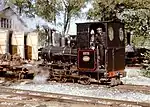 | 0-4-0 | 600 mm (1 ft 11+5⁄8 in) | 20 hp | Lotta 1 Östra Södermanlands Järnväg |
| 6625 | 1913 |  | 0-4-0T | 600 mm (1 ft 11+5⁄8 in) | Joh. Köppe, Bitterfeld, Finkenherd, Strabag, later Museum Prof. Dr. Bandtlow, Passau, preserved as Monika N° 3 at Besucherbergwerk Fortuna, Solms-Oberbiel, Germany | |
| 6641 | 1913 | 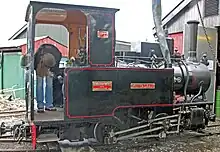 | 0-4-0 | 600 mm (1 ft 11+5⁄8 in) | 30 hp | Montalban, West Lancashire Light Railway |
| 6655 | 1913 |  | 0-4-2 | 3 ft (914 mm) | 50 hp | 2, ordered for FC de Pimentel, Peru |
| 6760 | 1913 | .jpg.webp) | 0-4-0 | 600 mm (1 ft 11+5⁄8 in) | Initially gas and electricity works, Stockholm, since 1918 Stockholm 5 at Stockholms Stads Lantegandomsnämnd, since 1933 Smöjens Kalkbrott 4, ausgemustert 1956.[62] | |
| 6763 | 1914 | _de_la_Pl%C3%A2tri%C3%A8re_(Gipsgruben)_de_Reisdorf%252C_Luxembourg_(Collection_Jean_Dahlem).jpg.webp) | Gypsum mines at Reisdorf in Luxemburg | |||
| 6770 | 1914 |  | 0-4-0 | 600 mm (1 ft 11+5⁄8 in) | 40 hp | Smedjebacken, Sweden |
| 6780 | 1913 | %252C_Estonia%252C_(Collection_M._Helme).jpg.webp) | 0-4-0 | 750 mm (2 ft 5+1⁄2 in) | 50 hp | 'E. V. Aegna Kommandatur N° 1' delivered to Peter the Great's Naval Fortress in Reval (Tallinn), Estonia |
| 6805 | 1914 |  | 0-4-0 | Millaquin Mill, Bundaberg, Queensland | ||
| 6884 | 1914 | %252C_Estonia%252C_(Collection_M._Helme)_01.jpg.webp) | 0-4-0 | 750 mm (2 ft 5+1⁄2 in) | 90 hp | 'E. V. Aegna Kommandatur N° 2' delivered to Peter the Great's Naval Fortress in Reval (Tallinn), Estonia |
| 6885 | 1914 | %252C_Estonia_(Collection_R.Kalda).jpg.webp) | 0-4-0 | 750 mm (2 ft 5+1⁄2 in) | 90 hp | 'E. V. Aegna Kommandatur N° 3' delivered to Peter the Great's Naval Fortress in Reval (Tallinn), Estonia |
| 6892 | 1920 | _en_1934_se_utiliz%C3%B3_una_locomotora_para_el_transporte_de_piedra_desde_la_cantera.jpg.webp) | 0-6-0 | 1,000 mm (3 ft 3+3⁄8 in) | 60 hp | Puerto de Adra, Spain |
| 6900 | 1920 | .jpg.webp) | 0-2-0 FL | 600 mm (1 ft 11+5⁄8 in) | 60 hp | Fireless locomotive of the yeast factory, Delft,[65][66] then Van het Hof, Pijnakker, rebuilt to 0-4-2T (B1 n2t) at Stoomtrein Katwijk Leiden, preserved at Rissens Leemspoor, Rijssens, Netherlands[67] |
| 6937 | 1914 | .jpg.webp) | 1'0-4-0 | 600 mm (1 ft 11+5⁄8 in) | 30 hp | Purwodadi 3, PG Purwodadi, Ngawi, Indonesia |
| 6944 | 1913 | .jpg.webp) | 0-8-0 | 600 mm (1 ft 11+5⁄8 in) | 100 hp | Purwodadi 5, PG Purwodadi, Ngawi, Indonesia |
| 6946 | 1913 | .jpg.webp) | 0-8-0 | 600 mm (1 ft 11+5⁄8 in) | 60 hp | Kedawung 14, PG Kedawung, Pasuruan, Indonesia |
| 6962 | 1913 |  | 0-4-0 | 600 mm (1 ft 11+5⁄8 in) | 20 hp | Valdés Vergara der Fleischverpackungsfabrik Bories, 4 km von Puerto Natales in Chile. Sie wurde 1915 von der Sociedad Explotadora de Tierra del Fuego gekauft. Sie wurde für die Ausstellung im Museum des Hotels The Singular Patagonia in den alten Industrieanlagen in Puerto Bories restauriert. |
| 6976 | 1913 | .jpg.webp) | 0-4-2 | 600 mm (1 ft 11+5⁄8 in) | 30 hp | Tasik Madu XV, Solo Java, Indonesia |
| 7063 | 1915 | 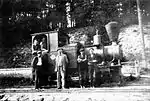 | 0-6-0 | 760 mm (2 ft 5+15⁄16 in) | Forest railwayy Rečkov | |
| 7067 | .jpg.webp) | 0-6-0 | 600 mm (1 ft 11+5⁄8 in) | 30 hp | Bakrie Sumatera Plantations Railway, Bunut, Kecamatan Kota Kisaran Barat, Kabupaten Asahan, Sumatera Utara, Indonesia | |
| 7086 | 1914 | ._750_mm_Bt-coupled_steam_locomotive_delivered_to_Ramseyer_%2526_Brechtb%C3%BChler%252C_Rubingen%252C_Switzerland.jpg.webp) | 0-4-0 | 750 mm (2 ft 5+1⁄2 in) | Tove. Geliefert an Ramseyer & Brechtbühler, Rubigen, Schweiz. Verkauft 1918 an die Baufirma Wright, Thomsen & Kier. Brabrand 1956. | |
| 7148 | 1914 |  | 2-8-0 | 3 ft (914 mm) | 200 hp | N° 1, ‘Pimentel’ ordered for FC de Pimentel, Peru |
| 7150 | 1914 | %252C_r%C3%A9quisitionn%C3%A9e_%C3%A0_la_soci%C3%A9t%C3%A9_Rondant_et_Demenois._1er_ao%C3%BBt_1916_(Fonds_Valois%252C_BDIC).jpg.webp) | 0-4-4-0 Mallet | La France bei Haudainville, beschlagnahmt bei der Firma Rondant & Demenois. | ||
| 7191-7198 | 1914 |  | 0-6-0 | 750 mm (2 ft 5+1⁄2 in) | 50 hp | Built at the Drewitz works for Peter the Great's Naval Fortress in Reval (Tallinn), Estonia. The Eesti V.R. locomotive T. 110 was industrially used in 1925 |
| 7194 | 1914 | 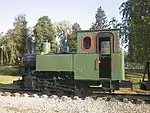 | 0-6-0 | 750 mm (2 ft 5+1⁄2 in) | 50 hp | Initially Peter the Great's Naval Fortress in Reval (Tallinn), Estonia, later military railway on Kirkkomaa Island, Kotka, since 1946 paper mill Äänenkoski, decommissioned in 1964, plinthed since 1982, Äänekoski Selluloosatehdas, Äänekoski, Finland |
| 7208 | 1914 |  | 0-10-0 | 750 mm (2 ft 5+1⁄2 in) | 750 hp | Peter the Great's Naval Fortress in Reval (Tallinn), Estonia, Eesti VR K4 |
| 7228 | 1914 | %252C_Lehmgrube_einer_Ziegelei_mit_Feldbahnzug_und_gleisgebundenem_Eimerkettenbagger.jpg.webp) | 0-4-0 | 720 mm | 50 hp | Brick works O. Stölzel, Gundorf near Leipzig, Germany |
| 7283 | 1920 | _en_O%2526K_9205_(1920)_op_de_bouwplaats_van_de_sluisput_van_de_Overlekersluis_bij_Medemblik%252C_genomen_op_30_mei_1928.jpg.webp) | 0-4-0 | 700 mm (2 ft 3+9⁄16 in) | 20 hp | G.J.A. van Shingerland, Oosterhout |
| 7300 | 1915 | .jpg.webp) | 0-6-0 | 600 mm (1 ft 11+5⁄8 in) | Lotta, Nr. 2, Lindfors-Bosjöns Järnväg[59][60] | |
| 7325 | 1920 | 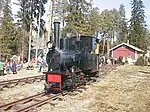 | 0-6-0 | 600 mm (1 ft 11+5⁄8 in) | Ojakkala–Olkkala railway, now heritage railway in Kowjoki, Finland | |
| 7429 | 1914 | %252C_030_T_n%C2%B0_19%252C_O%2526K_1914_-_7429%252C_50_ch%252C_ex_PKP%252C_02.06.2018_2.jpg.webp) | 0-6-0 | 600 mm (1 ft 11+5⁄8 in) | 50 hp | Chemin de fer des Chanteraines[68] |
| 7443 | 1919 | 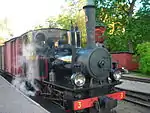 | 0-4-0 | 600 mm (1 ft 11+5⁄8 in) | 50 hp | Nr. 3 Dylta, Östra Södermanlands Järnväg |
| 7446 | 1916 | 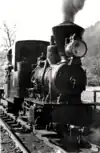 | 0-4-0 | 760 mm (2 ft 5+15⁄16 in) | 40 hp | Lotte, Phönix Stahlwerk, J. C. Bleckmann, Hönigsberg, Austria |
| 7459 | 1921 |  | 0-6-0 | 700 mm (2 ft 3+9⁄16 in) | Erst De Danske Hedeselskab, Jllan, heute Hedelands Veteranbane, Høje-Taastrup Kommune, Dänemark | |
| 7479 | 1918 | .jpg.webp) | 0-4-0 | 600 mm (1 ft 11+5⁄8 in) | 30 hp | Lukas, initially gravel pit Kissingen near Augsburg, later Schinznach-Dorf, Baumschulbahn (orchard railway), Converted into a tram engine |
| 7610 | 1918 | .jpg.webp) | 0-4-0 | 600 mm (1 ft 11+5⁄8 in) | Initially Kalk- u Mergelwerke Heinrich Möller, now Eisenbahnmuseum Bochum | |
| 7642 | 1922 |  | 0-6-0 | 762 mm | Initially Towada Railway & Co., Sanbongi-machi, Schi-no-hara, later Izumo, Ōigawa Tetsudō, Japan | |
| 7696 | 1919 | .jpg.webp) | 0-4-0 | 643 mm | № 5, Karolina, Delary-Strömsnäsbruks Järnväg, Sweden | |
| 7697 | 1920 |  | 0-4-0 | 600 mm (1 ft 11+5⁄8 in) | Bromberger Kreisbahn | |
| 1920 | .jpg.webp) | 750 mm (2 ft 5+1⁄2 in) | O&K No. 12, Bañoles, Palamós–Girona–Banyoles railway. They had six O&K locomotives, which had been built in 1910 for a contractor in Belgium. Five of these were 0-4-0 and one was 0–4–2. They were numbered 11 to 16 and were called Andrea, Bañoles, Celrá, Cornellá, Mercedes and Gerona.[69] | |||
| ca 1920 |  | 0-4-0 | ca 20 hp | |||
| 7729 | 1914 | .jpg.webp) | 0-6-0 | 785 mm (2 ft 6+29⁄32 in) | 140 hp | Basaltine, initially Basalt AG, Linz am Rhein, later playground at Bad Godesberg, now Rheinisches Industriebahn-Museum, Cologne, Germany |
| 7769 | 1918 | _lok_33._Loket_tillverkades1918_av_Orenstein_%2526_Koppel_Berlin-Drewitz%252C_tillverkningsnummer_var_OK_7769._Skrotades_1946.jpg.webp) | 891 mm (2 ft 11+3⁄32 in) (Swedish 3 ft gauge) | Stockholm–Roslagens Järnvägar No. 33 († 1946) | ||
| 7776-7780 | 1915 | .jpg.webp) | 0-4-0 | 760 mm (2 ft 5+15⁄16 in) | 90 hp | Lenz & Co GmbH, Berlin (Lenz Com 1379) |
| 7850 | _auf_der_Strecke_Jab%C5%82onna-Karczew_im_Bahnhof_Warschau-Most.jpg.webp) | 0-6-0 | Narrow gauge urban railway Jabłonna-Karczew, Poland | |||
| 7899 | 1921 |  | 0-4-0 | 750 mm (2 ft 5+1⁄2 in) | Zakłady Starachowickie 9, Starachowice, Polen | |
| 7875 | 1914 | .jpg.webp) | 0-8-0 | 600 mm (1 ft 11+5⁄8 in) | 70 hp | Pangka 9, PG Pangka, Slawi near Tegal, Indonesia |
| 7878 | 1914 | .jpg.webp) | 0-8-0 | 600 mm (1 ft 11+5⁄8 in) | 70 hp | Gempolkerep 11, Mojokerto, Indonesia |
| 1914 |  | D h2t | 785 mm (2 ft 6+29⁄32 in) | Oberschlesische Schmalspurbahn, Prussian T 38, Kattowitz 211 to 37, DR 99 411–421, 32,25 t | ||
| ca 1914 |  | C'1 n2t | 1,000 mm (3 ft 3+3⁄8 in) | Ferrocarril Argentino del Norte | ||
| before 1918 | .jpg.webp) | 0–10–0, Luttermöller | 600 mm (1 ft 11+5⁄8 in) | 90 hp | German military locomotive on the western front of world war I,[70] | |
| ca 1919 |  | E h2 | 785 mm (2 ft 6+29⁄32 in) | Oberschlesische Schmalspurbahn, Prussian T 39, gear-driven rear axles, System Luttermöller | ||
| 7900 | 1921 |  | 0-4-0 | 750 mm (2 ft 5+1⁄2 in) | Narrow gauge railway Rogów–Biała Rawska. It was working together with his twin 7899 in Starachowice. Now exhibited in Rogów railway museum | |
| 7908 | 1917 | .jpg.webp) | 0-6-0 | 600 mm (1 ft 11+5⁄8 in) | Heeresfeldbahn No 508 B, 99.3-016, Baba Milka, Niš, Serbia[71] | |
| 7961 | 1917 | .jpg.webp) | 0-8-0 | 891 mm (2 ft 11+3⁄32 in) (Swedish 3 ft gauge) | Bahnstrecke Nordmark–Klarälven, Sweden | |
| 7999 | 1914 | 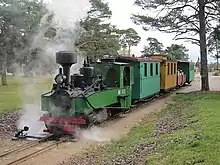 | 0-8-0 | 600 mm (1 ft 11+5⁄8 in) | Heeresfeldbahn Brigadelok No 482, depot administration of the 1. Eb-Brigade, Rehagen-Klausdorf (am Mellensee), later Polish State Railways PKP No 4232, since 1945 No ML 631 Latvian Railways LVD, since 1994 No ML 631, Museum of Maritime Fishing, Ventspils, Lithuania | |
| 8065 | 1916 |  | 0-6-0 | 1,067 mm (3 ft 6 in) | Initially Rotterdamsche Tramweg Maatschappij № 54, Hellevoetsluis, now Rotterdamsche Tramweg Museum RTM, Ouddorp, Netherlands | |
| 8083 | 1915 | _02.jpg.webp) | 0-4-0 | 600 mm (1 ft 11+5⁄8 in) | Tramway de Pithiviers à Toury and Chemin de fer Froissy-Dompierre | |
| 8090 | 1916 | .jpg.webp) | 0-8-0 | 600 mm (1 ft 11+5⁄8 in) | 1000 hp | Rejosari 10 Salak, PG Rejosari, Madiun, Indonesia |
| 8165 | 1916 | _Travelarz.jpg.webp) | 0-6-0 | 750 mm (2 ft 5+1⁄2 in) | Initially WKD 66, later Ty3-1162, Museum Sochaczew[72] | |
| 8271 | 1916 | 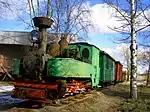 | Dn2t | 600 mm (1 ft 11+5⁄8 in) | Depot administration of the 1. Eb-Brigade, Rehagen-Klausdorf (am Mellensee) "853", since 1920 4CL-5 or ML 629 Latvian Railways LVD, since 1994 im agricultural museum Talsi, Latvia | |
| 8285 | 1917 |  | 0-10-0 | 600 mm (1 ft 11+5⁄8 in) | Initially Thalbahn Habsheim, later Tramway de Pithiviers à Toury No. 5-3, now Chemin de fer Froissy-Dompierre | |
| 8293 | 1916 |  | 0-6-0 | 700 mm | 70 hp | Initially Dononbahn, later Waldeisenbahn Alberschweiler, later Lambert Freres, Cormeilles-en-Parisis, now Stoomtrein Katwijk Leiden[73] |
| 8418 | 1917 |  | 0-6-0 | Initially 600 mm (1 ft 11+5⁄8 in), since 1919 760 mm (2 ft 5+15⁄16 in) | Depot administration of the 1. Eb-Brigade, Rehagen-Klausdorf (am Mellensee) No 487, since 1919 Hungarian forest railway No 357.305, later plinthed, saw mill Lenti, sice 1996 plinthed at saw mill Csömödér | |
| 8457 | 1921 |  | 0-4-0 | 600 mm | 20 hp | Spain, preserved at Museum Ponferrada, Spain ex Antracitas Gaiztarro[74] |
| 8500 | 1918 |  | Mariska, Goods railway station Dúbrava (now Vysoká pri Morave zastávka), Zohor–Záhorská Ves railway, Slovakia | |||
| 8575 | 1918 | _Travelarz.jpg.webp) | 0-8-0 | 600 mm (1 ft 11+5⁄8 in) | Nr. 1958, Depot administration of the 1. Eb-Brigade, Rehagen-Klausdorf (am Mellensee), later Tx 1958 Polish forest administration ZKL, forest railway Hajnowka, since 1987 railway museum Sochaczew, Poland | |
| 8590 | 1918 |  | 0-8-0 | 600 mm (1 ft 11+5⁄8 in) | 65 hpi | Tx 1113, Płociczno, Poland |
| 1918 | 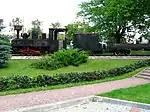 | 0-8-0 | 600 mm (1 ft 11+5⁄8 in) | 65 hpi | Tx 1114, Czarna Białostocka, Poland | |
| 8594 | 1918 |  | 0-8-0 | 600 mm (1 ft 11+5⁄8 in) | 70 hp | Initially T.P. Ruvenhorst & Humbert, now Association pour la préservation et l'entretien du matériel à voie étroite, Saint-Germain-d'Arcé, France |
| 8627 | 1918 |  | 0-8-0 | 600 mm (1 ft 11+5⁄8 in) | 70 hp | Initially Heeresfeldbahn Brigadelok No. 13, later Sucreries Coucy-le-Château, now Chemin de fer Froissy-Dompierre |
| 8718 | 1918 |  | 0-10-0 | 600 mm (1 ft 11+5⁄8 in) | Heeresfeldbahn No 2643 with outer frame and Luttermöller rear axles | |
| 8734 | 1918 |  | 0-10-0 | 600 mm (1 ft 11+5⁄8 in) | T914, sugar mill San Martin del Tabacal in Salta, Argentina | |
| ca 1919 | _-_Locomotive_a_vapeur_a_troix_essieux_accouples%252C_600_mm%252C_10200_kilos_-_Catalogue_N%C2%B0849%252C_1919_(15357367543).png.webp) | 0-4-0 | 600 mm (1 ft 11+5⁄8 in) | 5,4 t, heated by wood or coal | ||
| ca 1919 | _-_Locomotive_a_vapeur_a_troix_essieux_accouples%252C_600_mm%252C_10200_kilos_-_Catalogue_N%C2%B0849%252C_1919_(15357367543%252C_bottom).png.webp) | 0-6-0 | 600 mm (1 ft 11+5⁄8 in) | 10,2 t, heated by wood or coal | ||
| ca 1919 | _-_Locomotive_a_vapeur_a_2_essieux_accouples%252C_900-1000_mm%252C_20000_kilos_-_Catalogue_N%C2%B0849%252C_1919_(15951239076%252C_top).png.webp) | 0-4-0 | 900–1,000 mm (3 ft 3+3⁄8 in) | 20 t | ||
| ca 1919 | _-_Locomotive_a_vapeur_a_4_essieux_accouples_a_jeu_transversal%252C_110_cv_vapeur%252C_760_mm%252C_21000_kilos_-_Catalogue_N%C2%B0849%252C_1919_15976996445).png.webp) | 0-8-0 | 750 mm (2 ft 5+1⁄2 in) | 110 hp | 21 t | |
| ca 1919 | _-_Installation_pour_de_traveaux_de_remblai_en_Egypte_-_Catalogue_N%C2%B0849%252C_fran%C3%A7aise_(ca_1919)_(15976095962).png.webp) | Egypt | ||||
| ca 1919 | _-_Chemin_de_fer_de_Zambese_-_Catalogue_N%C2%B0849%252C_fran%C3%A7aise_(ca_1919)_(15976095962).png.webp) | Chemin de fer de Zambezia, Mozambique | ||||
| 8800 | 1920 | 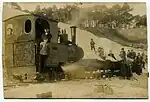 | 0-4-0 | 600 mm (1 ft 11+5⁄8 in) | 50 hp | Niederlausitzer Kohlenwerke (open cast lignite mines) |
| 8998 | 1923 |  | 0-10-0T | 1,000 mm (3 ft 3+3⁄8 in) | 200 hp | Railway Directorate Erfurt, Railway Station Meiningen, DRB 99 183, at DR converted in 1959 to 2-6-2T |
| 9067 | 1920 | 0-4-0 | 900 mm (2 ft 11+7⁄16 in) | 160 hp | Gemeentewerken, Deventer | |
| 9147 | 1919 | .jpg.webp) | 0-6-0 | Cement factory Klagshamn, Sweden[75] | ||
| 9103 | 1920 | .jpg.webp) | 0-8-0 | 600 mm (1 ft 11+5⁄8 in) | 60 hp | Rejosari 6 Arjuna, PG Rejosari, Madiun, Indonesia |
| 9135 | 1920 |  | 0-4-0 | 700 mm (2 ft 3+9⁄16 in) | 50 hp | Overysselsche Steenfabriek, Deventer, Netherlands |
| 9193 | 1920 |  | 0-6-0 | 1,067 mm (3 ft 6 in) | Erst Rotterdamsche Tramweg Maatschappij № 56, Hellevoetsluis, heute Rotterdamsche Tramweg Museum RTM, Ouddorp, Netherlands | |
| 9199 | 1920 | .jpg.webp) | 0-6-0 | Hällefors Bruk, No. 8, Sweden | ||
| 9234 | 1920 |  | 0-4-0 | 40 hp | Zylhoff & Zoon, brick factory De Vooruitgang in Terwolde, Netherlands | |
| 9244 | 1925 | 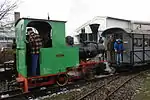 | 0-4-0 | 600 mm (1 ft 11+5⁄8 in) | 40 hp | Frankfurter Feldbahnmuseum No 18 |
| 9295 | 1922 | _auf_einem_Foto_von_Franz_Stoedtner_(1870-1946).jpg.webp) | 0-10-0 | 1,524 mm (5 ft) | 650 hp | Nydquist & Holm, Sweden for Soviet Russia goods locomotive with T4 Locomotive factory in Trollhättan N° 5080 class Eg |
| 9307 | 1920 | .jpg.webp) | 0-8-0 | 600 mm (1 ft 11+5⁄8 in) | 60 hp | Gempolkerep 18, Mojokerto, Indonesia |
| 9308 | 1920 | .jpg.webp) | 0-8-0 | 600 mm (1 ft 11+5⁄8 in) | 70 hp | Gempolkerep 2, Mojokerto, Indonesia |
| 9309 | 1920 | .jpg.webp) | 0-8-0 | 600 mm (1 ft 11+5⁄8 in) | 60 hp | Purwodadi 15, PG Purwodadi, Ngawi, Indonesia |
| 9310 | 1920 | .jpg.webp) | 0-8-0 | 600 mm (1 ft 11+5⁄8 in) | 70 hp | Wonolangan 3, PG Wonolangan, Probolinggo, Indonesia |
| 9349 | 1920 | .jpg.webp) | 0-8-0 | 600 mm (1 ft 11+5⁄8 in) | 90 hp | Tulungagung 2, Mojopanggung, Java, Indonesia |
| 9356 | 1920 | .jpg.webp) | 0-8-0 | 600 mm (1 ft 11+5⁄8 in) | 60PS | Kebonagung 10, PG Kebonagung, Malang, Indonesia |
| 9358 | 1920 | .jpg.webp) | 0-8-0 | 600 mm (1 ft 11+5⁄8 in) | 60 hp | Olean 5, PG Olean, Situbondo, Indonesia |
| 9382 | 1920 | .jpg.webp) | 0-8-0 | 600 mm (1 ft 11+5⁄8 in) | 80 hp | Prajekan 3, jetzt Asembagus 3, Asembagus, Situbondo Indonesia |
| 9412 | 1920 | .jpg.webp) | 0-8-0 | 600 mm (1 ft 11+5⁄8 in) | 60 hp | Asembagus 5, Asembagus, Situbondo Indonesia |
| 9414 | 1920 | _-_La_locomotora_No_11_marca_Henschel_%2526_Sohn_tipo_0-6-0_T_de_trocha_m%C3%A9trica.jpg.webp) | 0-6-0 | 1,000 mm (3 ft 3+3⁄8 in) | Ingenio Ledesma, Argentina | |
| 9418 | 1920 | 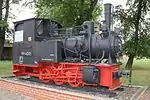 | 0-6-0 | 600 mm (1 ft 11+5⁄8 in) | KJI Nr. 23, Nr. 99 4301, Kleinbahnen des Kreises Jerichow I | |
| 9429 | 1920 | .jpg.webp) | 0-8-0 | 600 mm (1 ft 11+5⁄8 in) | 60 hp | Purwodadi 1II, PG Purwodadi, Ngawi, Indonesia |
| 9430 | 1920 | .jpg.webp) | 0-8-0 | 600 mm (1 ft 11+5⁄8 in) | 60 hp | Pagottan 3, PG Pagottan, Madiun, Indonesia |
| 9447 | 1910 | .jpg.webp) | 0-8-0 | 600 mm (1 ft 11+5⁄8 in) | 80 hp | Kanigoro 5, PG Kanigoro, Madiun, Indonesia |
| 9491 | 1921 | %252C_Orenstein_%2526_Koppel%252C_Werks-Nr._9491%252C_Bj._1921%252C_C_n2t%252C_400_PS%252C_1435_mm%252C_1940.png.webp) | 0-6-0 | 1,435 mm (4 ft 8+1⁄2 in) | 400 hp | N° 3 of Zschornewitzer Kleinbahn (ZKB) |
| 9550 and 9551 | 1921 |  | 0-6-0 | 762 mm (2 ft 6 in) | Oficina Peña Chica, Tarapacá Region, Chile | |
| 9454 | 1921 |  | 1D | 750 mm (2 ft 5+1⁄2 in) | № 7 Loviisa-Vesijärvi railway, now Jokioinen Museum Railway, Finland | |
| 9459 | 1920 | .jpg.webp) | 0-6-0 | 600 mm (1 ft 11+5⁄8 in) | Initially De Maas 3, now Asembagus 11, Asembagus, Situbondo, Indonesia | |
| 9468 | 1921 | 0–8–0, Luttermöller | Usina Santa Terezinha No. 14, Água Preta, Brazil | |||
| 9526 | 1921 | .jpg.webp) | 0–10–0, Luttermöller | 600 mm (1 ft 11+5⁄8 in) | 90 hp | Military locomotive 'E6' of the Imperial Japanese Army Field Railway[70] |
| 9537 | 1921 |  | 0–10–0, Luttermöller | 600 mm (1 ft 11+5⁄8 in) | 90 hp | Military locomotive 'E17' of the Imperial Japanese Army Field Railway,[70] |
| 9521-9545 o. 11071-11076 | 1921 or 1925 | .jpg.webp) | 0–10–0, Luttermöller | 600 mm (1 ft 11+5⁄8 in) | 90 hp | Military locomotive 'E1'-'E18' or 'E101'-'E106' of the Imperial Japanese Army Field Railway,[70] |
| 9584 | 1921 |  | 0-4-0 | 600 mm (1 ft 11+5⁄8 in) | Smedjebackens Valsverks AB, Sweden, N° 4 Erk preserved in Sunne, Sweden | |
| 9685 | 1922 |  | 0-6-2 | 1,000 mm (3 ft 3+3⁄8 in) | Initially Lok II of Staatliche Waldbahn Ruhpolding–Reit im Winkl, since 1940 Kleinbahn Leer–Aurich–Wittmund 14 | |
| 9704 | 1921 | .jpg.webp) | 0-4-0 | 600 mm (1 ft 11+5⁄8 in) | 40 hp | Semboro 6, PG Semboro, Jember, Java, Indonesia |
| 9752 | 1921 | 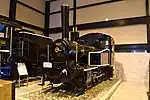 | Wakataka, Diorama Kyoto, Japan | |||
| 9785 | 1921 | 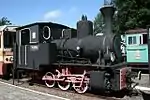 | 0-6-0 | 1,000 mm (3 ft 3+3⁄8 in) | Delivered to sugar factoriy Sobbowitz (785mm gauge), Ty 9785 of the sugar mill Gryfice, now exhibited at Pommersche Schmalspurbahnen in Gryfice[76] | |
| 9864 | 1922 | 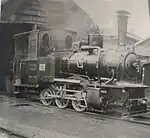 | 0-6-0 | 2 ft 6 in (762 mm) | 50 hp | N° 5 of the Uwajima Railway, the predecessor of the Yosan Line, shown here as Ke 223 of the government |
| 9881 | 1921 | .jpg.webp) | 0-4-0 | 600 mm (1 ft 11+5⁄8 in) | 40 hp | I, Zuckerfabrik PG Tasik Madu, I, Solo, Java, Indonesia |
| 9906 | 1922 | .jpg.webp) | 0-8-0 | 600 mm (1 ft 11+5⁄8 in) | 150 hp | Kebonagung 7, PG Kebonagung, Malang, Indonesia |
| 9908 | 1920 | _-_Locomotora_No_13_clase_0-4-0_T.jpg.webp) | 0-4-0 | 1,000 mm (3 ft 3+3⁄8 in) | Ingenio Ledesma, Argentina | |
| 9998 | .jpg.webp) | 610 mm (2 ft) | Elouise, initially Matas Nacionais, Portugal, now Old Kiln Light Railway at Rural Life Living Museum in Tilford, near Farnham, Surrey | |||
| 10145 | 1922 |  | 0-4-0 | 600 mm (1 ft 11+5⁄8 in) | 20 hp | Stoomtrein Katwijk Leiden |
| 10154 | 1922 | 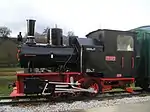 | 0-6-0 | 760 mm (2 ft 5+15⁄16 in) | 90 hp | Zreče, Slovenia.[77] Nos 10151–10180 were delivered to the SHS state railways (State of Slovenes, Croats and Serbs, later Kingdom of Yugoslavia) as German World War I reparations. |
| 10155 | 1922 | 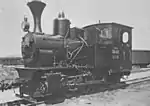 | 0-6-0T | 760 mm (2 ft 5+15⁄16 in) | Jugoslovenske Železnice, No 11034, JDŽ 71-014[77] | |
| 10156 | 1922 |  | 0-6-0 | 760 mm (2 ft 5+15⁄16 in) | Initially O-VIII, later SHS 3006, Jesenice Ironworks, later stored at Upper Sava Valley Museum, Jesenice, Slovenia[78] | |
| 10157–10177 | 1922 | 0-6-0 | 760 mm (2 ft 5+15⁄16 in) | Jugoslovenske Železnice, Nos 11021–11042, JDŽ 71–001 to 71-013 and 71–015 to 71-022[77] | ||
| 10168 | 1922 | 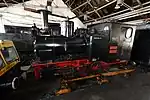 | 0-6-0 | 760 mm (2 ft 5+15⁄16 in) | Initially O-IX, later 71-012, Slovenian Railway Museum, Ljubljana operational, in use at Zreče, Slovenia | |
| 10261 | 1921 | _02.jpg.webp) | 0-6-0T+T | 600 mm (1 ft 11+5⁄8 in) | 50 hp | Lolita, built for Alfonso Pasquel, La Orduña Sugar Mill, Coatepec, Veracruz, Mexico |
| 10286 | 1926 | .jpg.webp) | 0-8-0 | 600 mm (1 ft 11+5⁄8 in) | 90 hp | Merican 7, PG Merican, Kediri, Indonesia |
| 10309 | 1922 | .jpg.webp) | 0-6-0 | 600 mm (1 ft 11+5⁄8 in) | 30 hp | Pulau Raja 2, Pulau Raja (PTP VI), Indonesia |
| 10372 | 1922 | .jpg.webp) | 0-8-0 | 600 mm (1 ft 11+5⁄8 in) | 90 hp | Pesantren 8, PG Pesantren Baru, Kediri, Indonesia |
| 10431 | 1922 |  | 0-4-0 | 500 mm (19+3⁄4 in) | 10 hp | Soc Agricola, Puente Pietra, Peru, probably used in Santa Rosa, Pueblo Nuevo, Chincha |
| 10442 | 1923 | .jpg.webp) | 0-8-0 | 600 mm (1 ft 11+5⁄8 in) | 150 hp | Pagottan 8, PG Pagottan, Madiun, Indonesia |
| 10443 | 1923 | .jpg.webp) | 0-8-0 | 600 mm (1 ft 11+5⁄8 in) | 60 hp | Gempolkerep 3L, Mojokerto, Indonesia |
| 10458 | 1923 | .jpg.webp) | 0-8-0 | 600 mm (1 ft 11+5⁄8 in) | 70 hp | Wonolangan 6, PG Wonolangan, Probolinggo, Indonesia |
| 10462 | 1921 | .jpg.webp) | 0-8-0 | 600 mm (1 ft 11+5⁄8 in) | 80 hp | Tasik Madu V, Solo Java, Indonesia |
| 10497 | 1922 | %252C_O%2526K_(N%C2%BA_10497_de_1925).jpg.webp) | 0-8-2T | Caminho de Ferro de Luanda, Angola, Nº 61, Classe 60 | ||
| 10499 | 1925 | %252C_O%2526K_(N%C2%BA_10499_de_1925).jpg.webp) | 0-8-2T | Caminho de Ferro de Moçâmedes, Angola, Nº 68, Classe 60 | ||
| 10501 | 1923 |  | 0-8-0 | 750 mm (2 ft 5+1⁄2 in) | 170 hpi | KJI Nr. 15 der Kleinbahnen des Kreises Jerichow I[79][80] |
| 10542 | 1923 |  | 0-6-0 | 760 mm (2 ft 5+15⁄16 in) | CFR 763.148, delivered via subsidiary in Budapest an Căile Ferate Forestiere (governmental forest railways) geliefert, now railway museum Sibiu (Hermannstadt), Romania | |
| 10548 | 1923 | 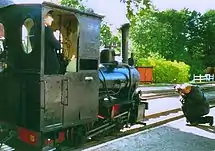 | 0-6-0 | 600mm | Erst Kungl Domänstyrelsen, Askekärr works, Stockholm, since 1937 Malma–Haggården railway, Kinnekleva, ca 1939 Nya Asfalt AB, ca 1942 Avesta Jernverks AB, since 1963 plinthed at Avesta, later Nr. 10, Avesta, Östra Södermanlands Järnväg | |
| 10550 | 1923 | .jpg.webp) | Forest railway in Sweden | |||
| 10551 | 1923 |  | 0-4-0 | 600 mm (1 ft 11+5⁄8 in) | Empresa Mineira do Lena, Portugal | |
| 10570 | 1924 | _02.jpg.webp) | 0-6-0 | 760 mm (2 ft 5+15⁄16 in) | Beregszentmiklós and 1937 Latorica, Ukraine | |
| 10591 | 1923 | .jpg.webp) | 0-8-0 | 600 mm (1 ft 11+5⁄8 in) | 60 hp | Sindanglaut 13, PG Sindanglaut 13, Cirebon Java, Indonesia |
| 10597 | 1923 | .jpg.webp) | 0-6-0 | 700 mm (2 ft 3+9⁄16 in) | 90 hp | Sakskøbing Sukkerfabrik N° B1, Denmark |
| 10606 | 1923 | .jpg.webp) | 0-10-0 | 600 mm (1 ft 11+5⁄8 in) | 120 hp | Pagottan 6, PG Pagottan, Madiun, Indonesia |
| 1930 and 1934 | 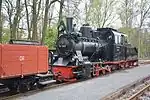 | 0-8-0 | 600 mm (1 ft 11+5⁄8 in) | Nr. 10II to 12II of Mecklenburg-Pommersche Schmalspurbahn (MPSB) | ||
| 10607 | 1934 | .jpg.webp) | 0-8-0 | 600 mm (1 ft 11+5⁄8 in) | 150 hp | Gempolkerep 12, Mojokerto, Indonesia |
| 10660 | 1923 |  | 0-6-0 | 600 mm (1 ft 11+5⁄8 in) | Sugar mill La Poveda in Arganda del Rey near Madrid, Spain | |
| 10726 | 1923 |  | 0-6-0 | 760 mm (2 ft 5+15⁄16 in) | Via subsidiary in Budapest to Wenkheim farm, Mosonszentmiklós, Ungarn, later Hungarian State Railways, forest railway Csömödér No 357.314, finally (shown at the front) Széchenyi-Museumsbahn, Nagycenk, Ungarn | |
| 10738 | 1924 | .jpg.webp) | 0-8-0 | 600 mm (1 ft 11+5⁄8 in) | 80 hp | Wringinanom 2, PG Wringinanom, Situbondo, Indonesia |
| 10739 | 1924 | .jpg.webp) | 0-8-0 | 600 mm (1 ft 11+5⁄8 in) | 80 hp | Tasik Madu IV, Solo Java, Indonesia |
| 10740 | 1923 | .jpg.webp) | B1 n2t | Merican 5, PG Merican, Kediri, Indonesia | ||
| 10750 | 1923 |  | 0-6-0+t | 600 mm (1 ft 11+5⁄8 in) | Initially Sragi 14 Max, now Statfold Barn Railway | |
| 10808 | 1924 |  | 0-6-0 | 610 mm (2 ft) | 90 hp | No. 6 Pedemoura was used in the Duero valley in Portugal, to transport coal from the Minas de Pejao to a jetty on the river. Now preserved on the Leighton Buzzard Light Railway. |
| 10844 | 1924 | 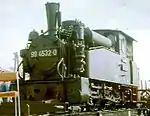 | 0-8-0 | 750 mm (2 ft 5+1⁄2 in) | Trusetal of Trusebahn[81] | |
| 10857 | 1924 | %252C_O%2526K_(N%C2%BA10857_de_1924).jpg.webp) | 0-6-0WT | Companhia do Assúcar de Angola, Fazenda S. Francisco, Dombe Grande, Nº 6 | ||
| 10891 | 1925 | .jpg.webp) | 0-8-0 | 600 mm (1 ft 11+5⁄8 in) | Tulungagung 3, Mojopanggung, Java, Indonesia | |
| 10903 | 1925 | ._It_was_employed_by_Lehane_McKenzie_%2526_Shand_Ltd_on_the_Fernilee_Reservoir_contract_(Real_Photographs_Co_Ltd%252C_W_8997).jpg.webp) | 0-4-0 | 914 mm (3 ft) | 90 hp | Kinder was used by Lehane McKenzie & Shand Ltd in the construction of the Fernilee reservoir in the Peak District of England |
| 10914 | 1924 | _Travelarz.jpg.webp) | 0-6-0T | 750 mm (2 ft 5+1⁄2 in) | 90 hp | Sugar Factory Zbiersk 4 |
| 10922 | 1925 |  | 1,067 mm (3 ft 6 in) | Kaijima class 32 at Nogata Coal Mine Museum | ||
| 10956 | 1925 |  | 0-10-0 | 600 mm (1 ft 11+5⁄8 in) | SMT T-907, sugar mill Ingenio San Martin del Tabacal in Argentina. Now on a private field near Sheffield, United Kingdom | |
| 11007 | 1925 | _Travelarz.jpg.webp) | 0-6-0 | 600 mm (1 ft 11+5⁄8 in) | Py4-741, Sochaczew, Poland[55] | |
| 11037 | 1925 | 0-6-0 | Polnische Schmalspurbahnen, Typ 3–191. Pińczówer Kleinbahn (Świętokrzyska Kolej Dojazdowa).[82][83] | |||
| 11073 | 1925 |  | 0-10-0 | 600 mm (1 ft 11+5⁄8 in) | 90 hp | Frankfurter Feldbahnmuseum Lok Nr. 16 |
| 11262 | 1926 | .jpg.webp) | 0-4-4-0 Mallet | 600 mm (1 ft 11+5⁄8 in) | 60 hp | Semboro 15, Zuckerfabrik PG Semboro, Jember, Java, Indonesia |
| 11139 | 1926 | .jpg.webp) | 0-8-0 | 600 mm (1 ft 11+5⁄8 in) | 110 hp | Pagottan 7, PG Pagottan, Madiun, Indonesia |
| 11142 | 1927 | .jpg.webp) | 0-8-0 | 600 mm (1 ft 11+5⁄8 in) | 90 hp | Gempolkerep 19, Mojokerto, Indonesia |
| 11277 | 1926 | .jpg.webp) | 0-4-4-0 Mallet | 600 mm (1 ft 11+5⁄8 in) | 60 hp | Asembagus 17, Asembagus, Situbondo, Indonesia |
| 11293 | 1926 | .jpg.webp) | 0-6-0 | 1,067 mm (3 ft 6 in) | 225 hp | Semboro 1, Jember, Java, Indonesia |
| 11309 | 1927 | 0-8-0 | 600 mm (1 ft 11+5⁄8 in) | 90 hp | Initially Company Azucarera Conception, Argentina. 2008 Preston Services, GB. 2019 to Böhmetalbahn, Walsrode, Germany. | |
| 11348 | 1927 | .jpg.webp) | 0-8-0 | 600 mm (1 ft 11+5⁄8 in) | 70 hp | Merican 8, PG Merican, Kediri Indonesia |
| 11350 | 1927 |  | 0-4-4-0 Kitson-Meyer | 600 mm (1 ft 11+5⁄8 in) | Ferrocarril Militar de Puente Alto al Volcán | |
| 11358 | 1927 | %252C_O%2526K_Nr._11358_von_1927%252C_50_PS%252C_600_mm%252C_Bt%252C_Joh._N._Heiss%252C_Dampfschotterwerk%252C_Stadtsteinach.jpg.webp) | 0-4-0 | 600 mm (1 ft 11+5⁄8 in) | 50 hp | Hard stone works and steam gravel works Hartsteinwerke Joh. N. Heiß in Stadtsteinach[84] |
| 11368 | 1928 |  | 0-4-0 | 600 mm (1 ft 11+5⁄8 in) | Lepra-Heilanstalt auf der Isla del Cerrito in Argentina | |
| 11420 | 1927 | .jpg.webp) | 0-6-2 | 700 mm (2 ft 3+9⁄16 in) | Sakskøbing Sukkerfabrik N° B2, preserved at Blovstrødbanen, Hillerød, Denmark ex Dansk Jernbane-Klub, Maribo CRJ 111/17 | |
| 11550 | 1927 | .jpg.webp) | 0-8-0 | 600 mm (1 ft 11+5⁄8 in) | 90 hp | Kebonagung 5, PG Kebonagung, Malang, Indonesia |
| 11563 | 1928 | .jpg.webp) | 0-8-0 | 600 mm (1 ft 11+5⁄8 in) | 110 hp | Rejosari 11 Gedek, PG Rejosari, Madiun, Indonesia |
| 11603 | 1928 | .jpg.webp) | 0-8-0 | 600 mm (1 ft 11+5⁄8 in) | 60 hp | Sindanglaut 12, Zuckerfabrik PG Sindanglaut 12, Cirebon, Java, Indonesia |
| 11638 | 1928 | .jpg.webp) | 0-8-0 | 600 mm (1 ft 11+5⁄8 in) | 150 hp | Gempolkerep 4, Mojokerto, Indonesia |
| 11648 | 1928 | .jpg.webp) | 0-4-0 | 700 mm | Veenpark, Barger-Compascuum (Gemeinde Emmen), Netherlands | |
| 11684 |  | 0-4-0 | 600 mm (1 ft 11+5⁄8 in) | Stoomtrein Katwijk Leiden | ||
| 11735 | 1928 | _and_behind_it_O%2526K_4930_of_1911_(preserved_at_De_Efteling_in_Kaatsheuvel)_at_Steenfabriek_IJsseloord_near_Arnhem_(Archieven.NL).jpg.webp) | Bn2t | 600 mm (1 ft 11+5⁄8 in) | 50 hp | Initially Steenfabriek IJsseloord near Arnhem, now Stoomloc 6 at Stoomtrein Katwijk Leiden Netherlands[85] |
| 11784 | 1927 |  | 0-6-0 | 600 mm (1 ft 11+5⁄8 in) | Caminho de Ferro Mineiro do Pejão, São Domingos, Portugal | |
| 11788 | 1929 | .jpg.webp) | 0-8-0 | 600 mm (1 ft 11+5⁄8 in) | Phosphate railway near the village of Vaitepaua in the north of the island Makatea[86][87] | |
| 11868 | 1929 |  | 0-4-0 | 700 mm (2 ft 3+9⁄16 in) | 50 hp | Spoorijzer 30, Netherlands[88] |
| 11927 | 1928 | .jpg.webp) | C fl | 600 mm (1 ft 11+5⁄8 in) | Semboro 3, Jember, Java, Indonesia | |
| 11198 | 1926 |  | 0-4-0 | 1,000 mm (3 ft 3+3⁄8 in) | Tren de Arganda bei Madrid | |
| 11695 | 1928 | 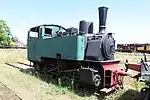 | 0-4-0 | 600 mm (1 ft 11+5⁄8 in) | Le Petit Train de la Baie de Saint-Brieuc, Association des chemins de fer des Côtes-du-Nord | |
| 11591 | 1928 | .JPG.webp) | 0-4-0 | 600 mm (1 ft 11+5⁄8 in) | Stoomtrein Katwijk Leiden | |
| ca 1928 |  | 2-6-0 | 1,000 mm (3 ft 3+3⁄8 in) | 22 t, Saigon–Mỹ Tho railway, Vietnam | ||
| 11990 | 1929 |  | 0-6-0 fl | 750 mm | Fireless locomotive, Äänekoski–Suolahti railway, Minkiö narrow gauge railway museum | |
| 12183 | 1930 |  | 0-6-0 | 914 mm | 50 hp | Sir William, ex sucrerie de Beauchamp, Musee L'Aventure du Sucre in Pamplemousse, Mauritius (or Deep River Sugar Estate, 750 mm)[89] |
| 12203 | 1933 | .jpg.webp) | 0-4-0 | 600 mm (1 ft 11+5⁄8 in) | 50 hp | Tulangan 5 Mojopahit, scrap heap at CV Tersana Baru, Kediri, Indonesia |
| 12234 | 1931 |  | 0-4-0 | 750 mm (2 ft 5+1⁄2 in) | 50 hp | Eight-wheel coupled locomotive, type D, 150 hp, for wood fuel with separate tender, delivered to A.O. Meyer, Hamburg for Siam, 4-axle bogie, Klien-Lindner hollow axles, sugar factory Lampang N° 9 |
| 12246 | 1933 |  | 0-4-0 | 600 mm (1 ft 11+5⁄8 in) | 50 hp | Yvonne, initially Steenfabriek Rijswijk Netherlands, later Eerste Drentse Vereniging van Stoomliefhebber EDS, Museum Veenpark |
| 12247 | 1911 | .jpg.webp) | Bn2t | 700 mm | 50 hp | Sawit Seberang 6 (früher 7), Sumatra, Indonesia |
| 12262 | 1931 | .jpg.webp) | 0-4-0 | 600 mm (1 ft 11+5⁄8 in) | Rendeng 08, PG Gondang Baru, Klaten, Indonesia | |
| 12331 | 1931 |  | 0-6-0 | 760 mm (2 ft 5+15⁄16 in) | Sub Nigel Gold Mines No. 3 in Dunnattar, Transvaal, South Africa | |
| 12350 | 1906 |  | 0-6-0 | 750 mm (2 ft 5+1⁄2 in) | 135 hpi | Prignitzer Kreiskleinbahnen No. 22, 99 4504; scrapped in 1966 |
| 12375 | 1932 | .jpg.webp) | 0-8-0 | 600 mm (1 ft 11+5⁄8 in) | 90 hp | Pangka 10, PG Pangka, Slawi bei Tegal |
| 12388 | 1932 | .jpg.webp) | 0-6-0 | Initially 762 mm (2 ft 6 in); later 600 mm (1 ft 11+5⁄8 in) | Initially Beau Sejour Estate, Mauritius, now L'Aventure du Sucre, Beau Plan, near Pamplemousses, Mauritius | |
| 12400 | 1932 |  | 2-8-2 | 900 mm (2 ft 11+7⁄16 in) | DR 99 2321–0, Bäderbahn Molli, Germany | |
| 12401 | 1932 | .jpg.webp) | 2-8-2 | 900 mm | DR 99 2322–8, Bäderbahn Molli, Germany[90] | |
| 12402 | 1932 |  | 2-8-2 | 900 mm | DR 99 2323–6, Bäderbahn Molli, Germany | |
| 12435 | 1933 | .jpg.webp) | 0-4-0 | 600 mm (1 ft 11+5⁄8 in) | 50 hp | Tulangan 2 Sriwijaya, Kediri, scrap metal merchant CV Tersana Baru, ex PG Tulangan, Sidoarjo Indonesia |
| 12473 | 1934 |  | 0-4-0T+WT | 1,600 mm (5 ft 3 in) | Orenstein & Koppel CSÉT Shunting Locomotives | |
| 12662 | 1935 | .jpg.webp) | 0-4-0T+WT | 1,600 mm (5 ft 3 in) | Orenstein & Koppel CSÉT Shunting Locomotives | |
| 12493 | 1934 | .jpg.webp) | 0-6-0 | 500 mm | 30 hp | Initially sugar factory Companhia de Assúcar de Angola, Fazenda Tentativa, Caxito, Angola, Nº 7, now Feldbahn-Museum 500, Nuremberg, |
| 12503 | 1934 |  | Initially 0–4–0, later 2-4-0 | 600 mm (1 ft 11+5⁄8 in) | Peter Büscher & Sohn, construction company, Münster, now No 43 heritage railway at Silver Dollar City, Missouri, United States | |
| 12350 | 1931 | .jpg.webp) | 750 mm (2 ft 5+1⁄2 in) | Initially MBB No. 9II, now Yekaterinburg children railway | ||
| 12513 | 1935 | .jpg.webp) | 0-6-2 | 600 mm (1 ft 11+5⁄8 in) | 135 hp | Estudios y Obras del Riachuelo, Buenos Aires, Argentina[91] |
| 12518 | 1934 | 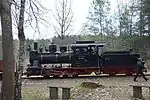 | 0-8-0 | 600 mm (1 ft 11+5⁄8 in) | MPSB 12, 99 3462, Dampf-Kleinbahn Mühlenstroth, No. 12, Mecklenburg | |
| 12536 | 1934 | %252C_O%2526K_(N%C2%BA_12536_de_1934).jpg.webp) | 0-4-0WT | Companhia de Assúcar de Angola, Fazenda Tentativa, Caxito, Angola, Nº 8 | ||
| 12540-12559 | 1934-1935 |  | 2-6-0 | 1,000 mm (3 ft 3+3⁄8 in) | Tatungen-Puchow Railway, China, with 3-axle tenders, weight in working order 28.3 t plus 21.5 t | |
| 12595 | 1935 | 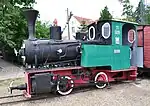 | 0-4-0 | 600 mm (1 ft 11+5⁄8 in) | T1-009, Narrow Gauge Railway Museum in Wenecja, Poland | |
| 12643 | 1935 | .jpg.webp) | 600 mm (1 ft 11+5⁄8 in) | Lundebanen | ||
| 12701 | 1936 |  | 0-4-0 | 600 mm (1 ft 11+5⁄8 in) | 50 hp | Delivered to G. Maar, Kaiserslautern, later construction company Tiefbaugesellschaft Oltsch & Cie, Zweibrücken N° 34 |
| 12708 | 1936 |  | 0-6-0 | 610 mm (2 ft) | Buckeye used in Africa, in the 1980s on Gwelo & District Light Railway in Zimbabwe and finally on Peter Nott's Norgrove Gardens Railway in California | |
| 12722 | 1936 |  | Bredgar and Wormshill Light Railway | |||
| 12740 | 1936 |  | 610 mm (2 ft) | In use until 1971 at Likomba Development Company, Cameroon, Africa, wood-fired, with a spark arrestor, now Elf, Leighton Buzzard Light Railway switched to coal | ||
| 12782 | 1936 |  | 0-6-0 | 750 mm (2 ft 5+1⁄2 in) | Initially Åminnefors Railway, Pohja, later Jokioinen Railway, Finland | |
| 12788 | ca. 1936 | _N%C2%B0_12788%252C_900_mm%252C_probably_in_%C4%90%C3%B4ng_Tri%E1%BB%81u%252C_Vietnam_(Flickr_50561369563).jpg.webp) | 0-4-0 | 900 mm (2 ft 11+7⁄16 in) | probably in Đông Triều, Vietnam | |
| 12861 | 1936 | .JPG.webp) | 0-4-0 | Trelew in Chubut, Argentina[92] | ||
| 12791 | 1936 | .jpg.webp) | 0-6-0 | 800 mm | Medine Estate, now Casela Bird Park, Cascavelle, Mauritius | |
| 12805 | 1936 | 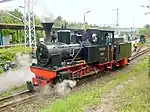 | 0-4-0 | 600 mm (1 ft 11+5⁄8 in) | Berliner Parkeisenbahn, Oberschöneweide, Germany | |
| 12814 | 1936 | .jpg.webp) | 0-6-0 | 600 mm (1 ft 11+5⁄8 in) | 40 hp | Gunung Malayu 01, Gunung Malayu, PT Lonsum Sumatra, Indonesia |
| 12900 | 1937 | .jpg.webp) | 0-4-0 | 600 mm (1 ft 11+5⁄8 in) | Initially Bungenäs, since 1951 Smöjens Kalkbrott 5 since 1964 in a museum in Gotland[62] | |
| 12974 | 1937 | .JPG.webp) | 600 mm (1 ft 11+5⁄8 in) | Stoomtrein Katwijk Leiden | ||
| 13088 | 1937 |  | 0-4-0T | 891 mm (2 ft 11+3⁄32 in) (Swedish 3 ft gauge) | 50 hp | Kullgrens Enka AB, Uddevalla, Sweden, initially preserved at Museum Uddevalla, now preserved at Hjo harbour, Sweden |
| 13021 | 1937 | .jpg.webp) | 0-6-0 | 920mm | 160 hp | SA Belge des Mines d'Aljustrel, Aljustrel, Portugal |
| 13103 | 1938 | .jpg.webp) | 0-4-0 | 750 mm (2 ft 5+1⁄2 in) | 110 hp | Quarz-Susi, Quarzwerke, Frechen, Bachem/Frechen, now Rheinisches Industriebahn-Museum, Cologne, Germany |
| 13118 | 1938 | .jpg.webp) | 0-8-0 | 600 mm (1 ft 11+5⁄8 in) | 90 hp | Jatibarang 12, PG Jatibarang, Tegal, Indonesia |
| 13165 | 1938 | .jpg.webp) | 0-4-0 | 600 mm (1 ft 11+5⁄8 in) | 70 hp | Deinste 9, Dossenheim quarries, Porphywerk Altvatter & Co, Dossenheim, later Witten-Bommern, Zeche Nachtigall coal mine |
| 13168 | 1939 | .jpg.webp) | Initially 0–4–0, later 2-4-0 | 600 mm (1 ft 11+5⁄8 in) | 70 hp | A31034/1, Müller-Altvater Co. construction company, Stuttgart, later Northfield & Cannon Valley Railroad in Northfield, Minnesota, now № 13 , heritage railway at Silver Dollar City, Missouri, United States |
| 13169 | 1939 |  | 0-4-0 | 600 mm (1 ft 11+5⁄8 in) | 70 hp | A31034/2, Müller-Altvater Co. construction company, Stuttgart, later Northfield & Cannon Valley Railroad in Northfield, Minnesota, now № 14, heritage railway at Silver Dollar City, Missouri, United States |
| 13177 | 1939 |  | ||||
| 13306 to 13308 | 1939 | 0-4-4-0, C'C' h4t, Kitson Meyer | 600 mm (1 ft 11+5⁄8 in) | 310 PSI, 250 PSE | DR 99 1641 to DR 99 1643, later PKP Tyyl-691 to Tyyl-693 | |
| ca 1940 | .jpg.webp) | Overburden locomotive | ||||
| 13571 | 1941 | 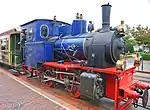 | 0-4-0 | 900 mm (2 ft 11+7⁄16 in) | 110 hp | Dollart (BorkumIII), Borkumer Kleinbahn[93] |
External links
- "Museal erhaltene Lokomotiven O&K, Werk Berlin". www.werkbahn.de. Jens Merte. January 1, 2014. Retrieved October 15, 2022.
- "Preserved Orenstein & Koppel Steam Locomotives". www.chm.bris.ac.uk. Martin Murray. April 30, 2001. Retrieved November 2, 2022. With web links to 50 photos.
- "845 locomotives built by: 'Orenstein & Koppel'". www.steamlocomotive.info. Doug Bailey. Retrieved November 2, 2022.
- 379 F. 3d 1227 — Ungaro-Benages v. Dresdner Bank AG at OpenJurist—U.S. Federal court case, wherein Benno Orenstein's great-great-granddaughter sued Dresdner Bank and Deutsche Bank to recover her family's share of O&K taken under Aryanisation.
- Documents and clippings about Orenstein & Koppel in the 20th Century Press Archives of the ZBW
Literature
- Roland Bude, Klaus Fricke and Martin Murray: O&K-Dampflokomotiven : Lieferverzeichnis 1892–1945. Verlag Railroadiana, Buschhoven 1978, ISBN 3-921894-00-X. (Partial reprint of an Orenstein & Koppel publication)
- Delivery lists of the locomotive works at werkbahn.de (nominal charge)
References
- 1 2 "INTERNATIONAL BRIEFS: Escalator Deal by Krupp". The New York Times. New York. Bloomberg Business News. January 16, 1996. Retrieved March 8, 2011.
- 1 2 Walker, Jonathan (March 1999). "O&K finds good home with New Holland—Orenstein and Koppel acquired by New Holland". Diesel Progress (North American Edition). Diesel & Gas Turbine Publications. Retrieved March 8, 2011.
- 1 2 "New Holland Acquires German Excavator Company". Rental Equipment Register. Penton Media. January 1, 1999. Retrieved March 8, 2011.
- ↑ "Will Sell Plant of German Concern" (PDF). The New York Times. New York. September 12, 1918. Retrieved March 10, 2011.
- 1 2 Tender-Lokomotiven mit zwei gekuppelten Achsen. O&K catalogue N° 800, page 27.
- ↑ Tender-Lokomotiven mit drei gekuppelten Achsen. O&K catalogue N° 800, page 34.
- ↑ Tender-Lokomotiven mit zwei oder drei gekuppelten Achsen und einer Laufachse. O&K catalogue N° 800, page 40.
- ↑ Lokomotiven für spezielle Zwecke, Doppel-Verbund-Lokomotiven (Bauart Mallet). O&K catalogue N° 800, page 44.
- ↑ Klien-Lindner Locomotives. German text. O&K Lokomotiven mit lenkbaren Kuppelachsen (Hohlachsen) mit Radial- und Seitenbewegung (Bauart Klien-Lindner). O&K catalogue N° 800, page 47.
- ↑ Lokomotiven mit lenkbaren Kuppelachsen (Hohlachsen) mit Radial- und Seitenbewegung (Bauart Klien-Lindner). O&K catalogue N° 800, page 48.
- ↑ Lokomotiven mit seitlich verschieblichen Kuppelachsen (Bauart Gölsdorf). O&K catalogue N° 800, page 53.
- ↑ Lokomotiven für Strassenbahnen. O&K catalogue N° 800, page 63.
- ↑ Mining and Tunnel Locomotives. O&K Lokomotiven für Tunnels und Bergwerke. O&K catalogue N° 800, page 60.
- ↑ Fireless Locomotives. O&K catalogue N° 850 (ca 1913), page 145.
- ↑ Friedrich Müller: Grundzüge des Kleinbahnwesens. Wilhelm Ernst und Sohn, Berlin, 1895.
- ↑ Zahnrad-Lokomotiven für vereinigte Reibungs- und Zahnbahnen. In: O&K catalogue N° 800, German, ca 1910, page 66.
- ↑ Jens Merte: Zahnradlokomotiven von Orenstein & Koppel.
- ↑ Rüdiger Fach: Werkfoto der Kitson Meyer Dampflokomotive. Erbaut von Orenstein & Koppel im Jahre 1927 mit der Fabrik-Nr. 11350. FFF-Info 2-2003, July 2003, page 13.
- ↑ Carina Majer: Als die Lok wegtransportiert wurde, waren meine Geschwister da.
- ↑ Orenstein & Koppel Fabr. Nr. 366, Baujahr 1899.
- ↑ Ulf Diehl: Okända ånglok. Sidospår 4/2009.
- ↑ Cukrownia Nakło 531.
- 1 2 3 4 5 6 7 8 9 10 11 12 13 14 15 John Browning: Orenstein & Koppel steam locomotives in Australia.
- ↑ "Dinty" in Service on the Gorge Line. Queenslander, 22 November 1928, p. 36.
- ↑ Kearsney-Stanger Light Railway 1901-c.1944.1 9 August 2010.
- ↑ Railway History Group: Bulletin No 113, November 2012.
- ↑ Derek A. Bayliss: The Origins of Orenstein & Koppel. The Industrial Railway Record. No 47, April 1973, p. 27-32.
- ↑ Crónicas de la vía estrecha (I R): De Valdepeñas a Puertollano en "el trenillo de La Calzá".
- ↑ Locomotive a 3 essieux accouples de 10 a 16 tonnes pour voies de 1000 et 1445 mm "Type entrepreneur" (O&K steam locomotive, works N° 1080, June 1903, 80 hp, 1000 mm gauge, Ct, 'Jallut über O&K Fil Brüssel'.)
- ↑ Señor Valero, Ejea de los Caballeros, Zaragoza, Spain.
- ↑ Museal erhaltene Lokomotiven O&K, Werk Berlin. 1 January 2014. Retrieved 4 February 2019.
- ↑ Ray Fox: The Origins of Orenstein & Koppel. The Industrial Railway Record. Nr. 46, February 1973, S. 361–371.
- ↑ Derek A. Bayliss: The Origins of Orenstein & Koppel. The Industrial Railway Record. Nr. 47, April 1973, S. 27–32.
- 1 2 Josef Pospichal: Bahnen auf der Insel Öland: Borgholm - Böda Järnväg (BBJ), 891mm.
- ↑ Josef Pospichal: Schwedische Industrie-Dampflokomotiven, 600mm, Teil 2 (G – M).
- ↑ Josef Pospichal: Schwedische Industrie-Dampflokomotiven, 891mm.
- 1 2 3 Locomotives of the South Western Railway Co. Ltd – The two-foot Narrow Gauge Forest Railroad in Knysna.
- ↑ Josef Pospichal: Ölands Järnvägar (ÖJ)
- ↑ BBJ 3 – ÖJ9 – SJ 3059.
- ↑ Parada Sud Quarry, 0-4-0T, No. LVD1, Montevideo, Uruguay.
- ↑ Josef Pospichal: Schwedische Industrie-Dampflokomotiven, 600mm, Teil 1 (A – F).
- ↑ F. Kemper: The origins of Orenstein & Koppel. The Industrial Railway Record, Nr. 40, S. 156–161.
- 1 2 Klaus Jünemann, Wolf-Dietger Machel and Lothar Nickel: "Marie Klockow kümmt!" Die Geschichte der ehemaligen Kleinbahn Klockow– Pasewalk, 1. Teil
- 1 2 Klaus Jünemann, Wolf-Dietger Machel und Lothar Nickel: "Marie Klockow kümmt!" Die Geschichte der ehemaligen Kleinbahn Klockow–Pasewalk, 2. Teil. Transpress Modell Eisenbahner, 2/86, ISSN 0026-7422, p. 4
- ↑ Arthur, Aquilla et Birland.
- 1 2 Malcolm Ravensdale: The Secondary Railways of France (Les Chemins de Fer Secondaires Français) - Lot-et-Garonne 7. 20 November 2020.
- ↑ The Cuba review, Band VIII, June 1910, Nr. 7, S. 300.
- ↑ Murray: O&K Nº 4017/1910.
- ↑ Orenstein & Koppel No. 4058. Remains plinthed at Carnarvon.
- 1 2 Ferrocarril de Valdepeñas a la Calzada de Calatrava y Puertollano. 3 May 2012.
- ↑ Carlos Mey: Historia y Arqueología Marítima – A la reconquista del ignoto ferrocarril al puerto. Pistas para reconstruir la olvidada historia del Ferrocarril de Reconquista a Puerto Reconquista.
- ↑ Decauville (kereta api industri) - Ponen II lokomotif uap terakhir di Rejo Agung Decauville (kereta api industri) - Ponen II lokomotif uap terakhir di Rejo Agung.
- ↑ A.E. Durrant: Photo of Rejoagung № 23 Ponen,
- ↑ 三重軌道 and 四日市鉄道
- 1 2 Bogdan Pokropiński: Muzealne parowozy wąskotorowe w Polsce (dla toru szerokości 600 i 630 mm). Żnin: Muzeum Ziemi Pałuckiej, 2000. ISBN 83-910219-7-1. S. 9.
- ↑ Orenstein & Couple feuerlose Dampflokomotive Typ Zarciremos
- ↑ Josef Pospichal: Schwedische Industrie-Dampflokomotiven, 600mm, Teil 4 (T – Ö).
- ↑ Visitors Guide. Bredgar and Wormshill Light Railway. 2008.
- 1 2 BBV - Bosjöbanans Vänner.
- 1 2 Lars-Gunnar Nyqvist: (LBB) Lindfors-Bosjöns Järnväg.
- ↑ Rio Negro Dam project, Argentina 0-4-0WT No. 'Rebecca', Devon Railway Centre, Bickleigh, Devon, UK.
- 1 2 3 4 Josef Pospichal: Schwedische Industrie-Dampflokomotiven, 600mm, Teil 3 (N – S).
- ↑ Museal erhaltene Lokomotiven O&K, Werk Berlin.
- ↑ EFPP (CBCPP) No. 10, Perus, Brazil.
- ↑ Orenstein & Couple feuerlose Dampflokomotive Typ Zarciremos
- ↑ O&K 6900 (1913) is ontspoord. Gistfabriek Delft, 1951 (collectie J. van der Stel; met dank aan Martin van Oostrom).
- ↑ Lokomotive 3 van de Stichting Rijssens Leemspoor (SRL).
- ↑ Notice no PM92000245, base Palissy, ministère français de la Culture
- ↑ Ángel Rivera: Crónicas de la vía estrecha (LX R): De Palamós a Girona y Banyoles en "el tren petit" ...y el tren "pinxo" 4 November 2018.
- 1 2 3 4 Udo Przygoda, Andreas Christopher, Rüdiger Fach, Felix Grassel, Stefan Kaiser und Matthias Koch: Heeresfeldbahnlokomotive O&K 11073/1925 (Lok 16 des Frankfurter Feldbahnmuseums). , FFM-Info E103
- ↑ Cn2t.
- ↑ Ty3-1162
- ↑ Stoomlok 7, Stoomtrein Katwijk Leiden.
- ↑ El Ferrocarril de Ponferrada a Villablino ... y otros rincones ferroviarios en El Bierzo.
- ↑ John Bergman: Orenstein & Koppel, Berlin (OK).
- ↑ Bogdan Pokropiński: Parowóz przemysłowe Ty-9785. In: Świat Kolej Nr. 8/2010, S. 30–31.
- 1 2 3 Josef Pospichal: JDŽ 71: SHS 3001 - 3030
- ↑ Pospichal, Josef. "Železarna Jesenice". Lokstatistik. Retrieved January 30, 2011.
- ↑ O&K 10501.
- ↑ O&K 10501 - DR "99 4644-3"
- ↑ O&K 10844.
- ↑ Klaus Jünemann und Klaus Kieper: Die Triebfahrzeuge der polnischen Schmalspurbahnen. Der Modelleisenbahner 4, 1970, S. 124.
- ↑ Ulrich Thorhauer : Świętokrzyska Kolejka Dojazdowa - 600/750 mm. Früherer Name: Jedrzejowska KD..
- ↑ Als in Stadtsteinach die Bockela-Bahn fuhr.
- ↑ Stoomloc 6, Ijsseloord.
- ↑ S. C. Martin: Makatea - About Half-way between Australia and South America. From Walkabout magazine, September 1st, 1948 LRRSA Light Railways, Nr. 169, February 2003.
- ↑ Musterlok - O&K 4028/1910.
- ↑ Stoomlocs voor de verhuur van Spoorijzer.
- ↑ Jean-Luc Faure: Tourisme ferroviaire a Maurice.
- ↑ Fahrzeugportrait O&K 12401-
- ↑ Por la Ribera del Riachuelo... ¡En Tren!
- ↑ Martin Coombs: Oddments of all kinds - Grun & Bilfinger SA, contractors.
- ↑ O&K 13571.










%252C_'Maleras'%252C_90_PS%252C_Spurweite_600_mm%252C_Dienstgewicht_ca_15000_kg.jpg.webp)
%252C_110_PS%252C_Spurweite_800_mm%252C_Dienstgewicht_ca_22000_kg%252C_f%C3%BCr_Holzfeuerung.jpg.webp)
%252C_20_PS%252C_Spurweite_750_mm%252C_Dienstgewicht_ca_5700_kg%252C_f%C3%BCr_%C3%96lfeuerung.jpg.webp)
%252C_90_PS%252C_Spurweite_600_mm%252C_Dienstgewicht_ca_12800_kg.jpg.webp)
%252C_140_PS%252C_Spurweite_1000_mm%252C_Dienstgewicht_ca_21000_kg.jpg.webp)
%252C_160_PS%252C_Spurweite_750_mm%252C_Dienstgewicht_ca_24000_kg.jpg.webp)
%252C_60_PS%252C_Spurweite_750_mm%252C_Dienstgewicht_14000_kg%252C_f%C3%BCr_Holzfeuerung.jpg.webp)
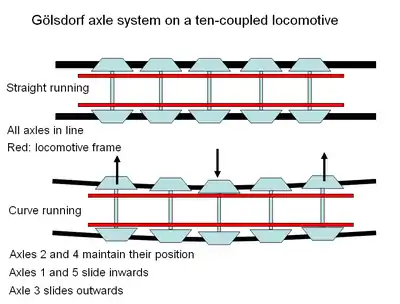





%252C_page_145%252C_Fig._9134%252C_O%2526K_Fireless_Locomotive_for_Standard_Gauge%252C_Service_Weight_15_tons.jpg.webp)

